

The Daily Iowan
LESTER REVAMPS IOWA
Iowa football offensive coordinator Tim Lester is shaping an offense off of a perilous previous season.
Colin Votzmeyer Sports Editor colin.votzmeyer@dailyiowan.com
While the onus is often on his players to put in the extra work, get an extra rep, and rebuild the Iowa football offense, Tim Lester ensures the same applies to him.
Coaches aren’t required to be the first one in the building or the last one to leave it. But when starting tight end Luke Lachey got to an offseason lift at 5 a.m., just weeks after Lester’s hiring as offensive coordinator, he peeked into his coach’s office window and caught him already watching game film.
Thus, Lachey’s first interactions with Lester were learning connections, with Lachey spending half an hour in Lester’s office discussing just one aspect of the offense alone.
“Coach Lester’s awesome; it’s great to have him here,” Lachey said. “It was really cool to be able to learn some new things … He really cares about us. He puts in a lot of work for us to succeed.”
Lester joined the Hawkeyes this season to replace head coach Kirk Ferentz’s son, Brian, at the offensive coordinator position after Brian Ferentz’s rollercoaster ride of stipulations and struggles throughout the 2023 season. These stipulations included a reworked contract for Brian Ferentz, requiring the team to average at least 25 points per game. Otherwise, his contract would be terminated.
So, a long season of grueling and gritty wins were motivated much by a stout defense instead. The Hawkeyes averaged just over 15 points — en route to the season’s worst offense in college football — leading Brian Ferentz and Iowa football to part ways.
In came Tim Lester, a 47-year-old family man from Wheaton, Illinois, with a lesser-known name but a soft demeanor and knack for the brains of football. His intellect and football savvy have quickly proven themselves through his natural ability to analyze a play in true depth and describe in detail what’s missing.
Lester’s contract runs through the first half of 2026. His salary is just over $1 million — up from Brian Ferentz’s $850,000.
And where Hawkeye fan reactions were mixed — as they always are — Lester’s resume looked to hit “reset” on this offense and even justify the hefty paycheck.
With 22 years of coaching experience across all levels of football, Lester piqued Kirk Ferentz’s interest while embedded with the NFL as a senior analyst for the Green Bay Packers.
His tenure with the Packers included an impressive flip of the season from a 2-5 start to a 9-8 record and second-place finish in the NFC North come playoffs — much behind the development of quarterback Jordan Love.
The No. 7 Packers then stunned the No. 2 CowLESTER | 2A

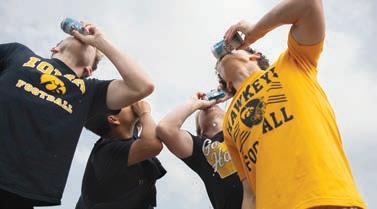
Evan Watson News Reporter news@dailyiowan.com
Construction on a new, casual, traditional-Japanese-inspired restaurant on Iowa City’s north side is nearly complete. Once the space is fully moved in, service is expected to begin before the month is out, offering a welcoming and diverse dining experience to Iowa City.
The new restaurant is coming to Iowa City from the two co-owners and the chef behind the nationally-acclaimed Iowa City restaurant The Webster. They are partnering with a longtime staff member who originally introduced the idea of Paper Crane two years ago.
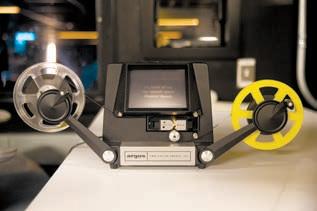
The Webster is known for its upscale environment serving American cuisine. Still, the staff working on the new restaurant want to achieve the opposite with their new restaurant, Paper Crane Ramen Shop and Cocktail Lounge.
Paper Crane will be located at 121 N. Linn St. and is eyeing its first day of business by the end of the month.
The restaurant is modeled after traditional Japanese ramen bars, offering a more casual dining experience, Chief Partner and long-time Webster team member Edwin Lee said.
Traditional Japanese ramen bars are small, fast settings with room to sit at the bar and with other seating around the perimeter. Ramen bars are typically peaceful environments that separate the dining environment from the busy outside world, Lee said.
“It’s meant to be more approachable in terms of environment, vibe, and price point,” he said. “In Japan, it’s very fast and casual where you come in, and it’s on your lunch break. It’s a food that blue-collar people and office workers come in and, really quickly, sit down for 20 minutes and eat.”
Lee said concepts for the new restaurant began in 2022 when he approached his boss, The Webster’s co-owner and chef Sam Gelmen, about a ramen pop-up dinner, which is, by design, a onetime dining event featuring food not typically on the menu.
restaurant’s focus, including a vegan option that can be customized with a variety of protein choices.
“We closed down the Webster for one night just to do this pop-up dinner and it went pretty well,” Lee said. He said that pop-up dinner’s success guided further conversations about Paper Crane. After that, Lee, Sam Gelmen, and his wife Riene Gelman agreed to go in on this new venture together. The restaurant’s theme and menu include multiple Japanese-inspired items. Lee said five different types of ramen will be the
Sam Gelman, co-owner of The Webster, said the process to open Paper Crane has taken most of the two years since the original pop-up dinner took place. It took time to find a suitable space and settle the lease with the previous tenant. By early 2024, construction began to design the space into what will now be Paper Crane, he said. Sam Gelman said the work yet to be completed is the most important and timely to
JoCo passes agreement to curb gun violence
Map by Emily Pavlik | The Daily Iowan

sion rate
• 23 fumbles and 11 of them lost
Champions in the San Francisco 49ers.
But much of the attraction behind Lester stemmed from his head coaching tenure at his alma mater Western Michigan — a frequent foe of the Iowa Hawkeyes — from 2017 to 2022. Lester was a four-year starting quarterback in Kalamazoo from 1996 to 1999. Upon his graduation, he finished his career fourth in FBS history in passing yards with 11,299 and sixth in touchdown passes with 89 in addition to 17 passing records and eight Mid-American Conference records. Returning to coach almost two decades later, Lester led the Broncos to 37 wins, three bowl game appearances, and — most importantly — an offense that ranked in the top 35 nationally in total offense from 2018 to 2021.
Now, in Iowa City, Lester is towing a line between adjustment and excitement.
Iowa wide receiver Jacob Gill described Lester’s demeanor around the field as “a little bit in between” vocal and quiet.
“When there’s things that need to be addressed, he addresses them, and then we make plays; he’s there for us; he’s excited for us,” Gill said. “And then when we have to go through things on our own, he lets us go through that as well, growing pains and things like that.”
Lester assumed what one could call an “it can only get better from here” offense after last season.
Across the 2023 campaign, the Hawkeyes posted: 234.6 yards of total offense per game
• 22 touchdowns, including only nine passing touchdowns to 11 interceptions 115.9 rushing yards per game and 11 rushing touchdowns
• 60 third down conversions on 204 chances for a 29.4 percent conver -
33 sacks 181 first downs • 15.43 points per game
This year, things are different.
Glimpses of hope have sparked up across the Iowa football atmosphere with the arrival of the new coach.
Lester’s offense is certainly flashier, even if only slightly so, for example, evidenced by a more confident orientation toward the pass to wide receiver weapons Reece Vander Zee, Jacob Gill, and Addison Ostrenga. Or a flea-flicker against Ohio State.
In fact, the Hawkeyes posted 40 points in their season-opening win over Illinois State on Aug. 31, in which quarterback Cade McNamara threw for 251
“The more people we get out there, everyone gets excited, and they’re ready to go, and everyone’s supporting one another,” Lester said. “When Sully scored, Cade was the first one celebrating with him.”
But it is Iowa football, after all, and Lester won’t escape his boss’ undying love for the run game.
Luckily, running back Kaleb Johnson has been a bright spot, especially with the solid Hawkeye offensive line.
Johnson is a rushing powerhouse, sitting second in the country in rushing yards with 937 in addition to his 12 touchdowns. For example, he scored three against Minnesota on 206 yards.
Unluckily, the offense has grown increasingly dependent on the run game as the pass block is
gathered just 18 first downs and 334 yards of total offense, which makes it that much harder on everyone else to win football games.
There, Johnson had to step in and explode to give Iowa even the slightest chance.
McNamara has shown glimpses of his success, but questions certainly shoot back to the system when he suddenly can’t get going.
It’s hard to repeatedly place blame on a player’s lack of preparation when he’s proven what he can do, too.
Lester said he’s proposed implementing and calling more deep-shot pass plays “in a group forum” but has been voted down. In fact, Lester notably called such plays a “risk.”
“It’s just the way the game is being played,” he said. “I’ve called a game where I called 70 passes,
“When there’s things that need to be addressed, he addresses them, and then we make plays; he’s there for us; he’s excited for us. And then when we have to go through things on our own, he lets us go through that as well, growing pains and things like that .”
Jacob Gill Iowa wide reciever
yards and three touchdowns. Six Hawkeyes recorded double-digits in receiving yards.
The Iowa offense totaled 23 first downs and 492 total offense yards, making for a difficult team to beat in any circumstance.
On Sept. 14, Iowa scored 38 points against Troy as McNamara posted an impressively solid 176 yards on 19-of-23 passing. Seven Hawkeyes recorded double digits in receiving yards.
In fact, Lester has made frequent use of backup quarterback Brendan Sullivan, a Northwestern transfer nicknamed “Sully,” in the red zone — something his predecessors never would have tested out. And Sullivan threw a touchdown dish to Ostrenga against the Trojans, that game seeing 25 first downs and 462 yards of total offense.
much weaker than the run block — and as McNamara has struggled to maintain consistency.
“As far as an overview, four weeks in, offensively we’re chasing consistency really in all phases,” Lester said at a press conference across the bye week after the win at Minnesota. “We have shown improvement from week to week in certain phases … Time on task is a real thing on offense, especially in the passing game.”
Some forget Lester is also Iowa’s quarterbacks coach, and that position has proved to be this program’s Achilles heel since the departure of Nate Stanley in 2019.
And where McNamara struggles, the team does, too. A case in point was the nail-biter over Minnesota, 31-14, on Sept. 21. With McNamara just 11-of-19 for 62 yards, the Iowa offense
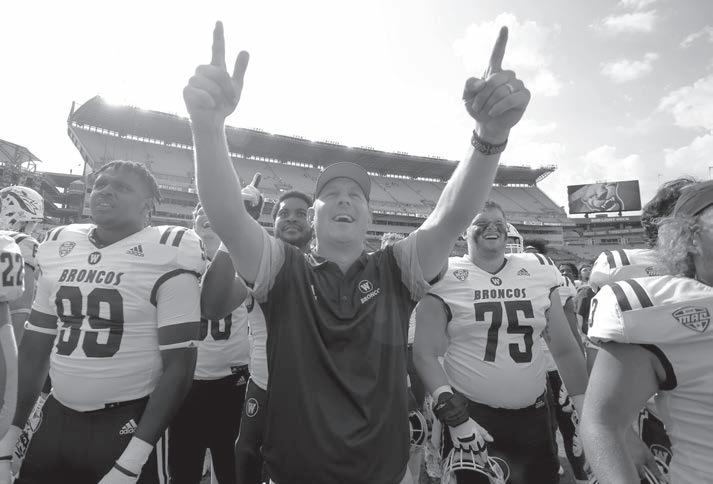



second half, producing a loss. It’s a team game, and the offense’s silent complacency left the defense out to dry for the last 30 minutes of game clock. McNamara finished 13-of-29 for 99 yards with no touchdowns and two interceptions — including 3-of-10 for 19 yards in the second half. No receivers got going, and Iowa’s nationally famous tight ends were muted.
But again, against then-No. 3 Ohio State on Oct. 5, the first half looked bright with both sides of the ball locked in and the Buckeyes leading just 7-0.
Where Iowa needed a slight spark in the second half to keep pushing, it withered away as McNamara threw for 98 yards and no touchdowns with a pick and two fumbles. That left the defense continuously exposed to a powerhouse Buckeye offense that only beat it down.
In Iowa’s 40-16 win over Washington, though, the Hawkeye offense put together its first truly complete game this season.
As Lester dialed in on his offensive schematics with effective counters and play fakes, he flexed the wider array of weapons at his disposal that were hidden before.
The result was the obvious 106 passing yards and two touchdowns with no turnovers from McNamara and 166 rushing yards and two touchdowns from Johnson.
Moreover, Lester really tapped into the offense’s depth, and it has improved ball progression and scoring capabilities unimaginable to last year. Seven Hawkeyes rushed the ball against Washington, and five grabbed a reception — including redshirt freshman Dayton Howard.
“I think offensively we’re gaining ground — not where we want to be yet, but we’re getting there and did some good things,” Ferentz said after the game. “In every area, we need to be more consistent. That’s probably the biggest thing here as we go forward.”
and I’ve called a game where I called 70 runs. We were just running the ball at a really high level. We had a lead, and we chose not to take that risk.”
And while play calling is no longer the tiresome issue it was one year ago, Johnson can’t carry the brunt of the load forever.
In Week 2 on Sept. 7, after the No. 21 Hawkeyes hosted unranked Iowa State and needed to be perfect to make the College Football Playoff, the defense can’t absorb all the fault as it surrendered all 20 Cyclone points in the
Today, the Iowa offense sits tied for 64th in scoring offense across the nation with 29.2 points per game and 94th in total offense with 357.5 yards per game. It’s not perfect, but it looks that way from the perspective of one season ago.
Indeed, it’s a team game. And at the end of the day, it’s clear Lester is trying to keep the fun in football — especially as he does everything he can to diversify the playbook portfolio.
“The fun is in the work, and our guys have been enjoying the different things we’ve been trying to do,” Lester said. “Problems are going to come and go. We’re going to get better at things as we go.”


Digital
Audience
DITV Sports Director AJ Reisetter aj.reisetter@dailyiowan.com
Grace Smith | The Daily Iowan
Iowa offensive coordinator Tim Lester points to head coach Kirk Ferentz during a press conference at the Hansen Football Performance Center in Iowa City on Feb. 6. Ferentz announced on Jan. 31 that former senior analyst for the Green Bay Packers Tim Lester will serve as the next offensive coordinator for the Hawkeyes.
Charles LeClaire | USA TODAY Sports Sep 18, 2021; Pittsburgh, Pennsylvania, USA; Western Michigan Broncos head coach Tim Lester (middle) and players react to their fans after defeating the Pittsburgh Panthers at Heinz Field. The Broncos won 44-41

OPINIONS
FIXING THE ELECTION
It’s time to change Election Day
We need to rethink how and when we vote in elections to reflect modern realities.

Carson Hartzog Opinions Editor
ing voting laws. In 2021, several right-wing lobbies and dark money funders were exposed for funneling millions of dollars into passing stricter voting laws. Their goal was simple: favor Republican candidates and block Democrat-backed voting rights bills. This attempt to skew voting laws hasn’t changed.
Our current Election Day processes make no sense. Our response to this lunacy — from absentee voting to in-person voting laws — makes even less sense.
I was 17 when I first became aware of this madness. Coincidentally, it happened during my AP Government and Politics class, one of the courses that fulfilled which is Illinois’ civics requirement.
My parents voted in every election, even the year my dad was at in the urgent care center. The expectation was that I’d do the same. I understood my civic duty and saw it as a badge of honor — a symbol of American democracy and a voice for the people.
You can imagine my confusion when I read 2 U.S. Code Section 7, which defines Election Day as “the Tuesday next after the first Monday in November.”
Here’s how my junior year social studies teacher Mr. White explained it: Federal law requires congressional and presidential elections to be held on the first Tuesday after the first Monday in November.
For many of us, this means Election Day falls on an inconvenient day. It also guarantees that every four years, members of Congress across party lines debate the impracticality of this schedule while failing to enact change or even reach a hint of a bipartisan consensus.
This cycle of debate has been ongoing since the law’s passage in 1845. Since then, the U.S. has industrialized, debatably re-industrialized, amended the Constitution to include a woman’s right to vote, and passed the Civil Rights Act of 1964.
But has the government changed the day Americans vote?
Nope. Oddly enough, the most recent constitutional amendment proposed in 1789 wasn’t enacted until 1992. That amendment, the 27th, prevents changes to congressional salaries from taking effect until after the next election.
Despite its intention, the amendment has done little to suppress corruption among election officials, especially regard-
Before 1845, states could hold elections any time within a 34-day period before the first Wednesday of December. Keep in mind, this system was used during a time when communications were limited to physical mail delivery carried by a horse and cart.
This monthlong process allowed states to choose a date best suited for their constituents. The hope, after all, was to get as many voters as possible.
As America’s communication systems and travel networks developed, so did the need for an established Election Day. When the law was passed, 69 percent of the workforce was farmers, many of whom required travel days to vote. Naturally, voting laws were written to accommodate their schedules.
By 1845, market days were typically held on Wednesday, which meant Monday and Thursday were out of the picture. Most Americans were also devout Christians, so Sunday wasn’t a viable option. That left Tuesday, Friday, and Saturday. Elected officials decided on Tuesday.
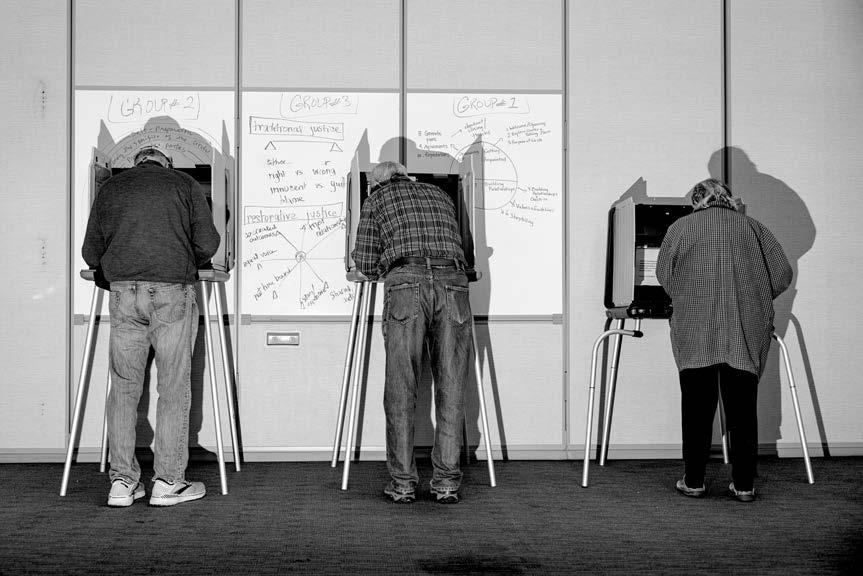
Consider this: Today, only two percent of Americans work in agriculture. Compare that to the 78.7 million Americans working hourly jobs, and you start to wonder why Election Day is still held on Tuesday.
Since then, little has changed — unless you count the rise in electric vehicles, the 74.6 million women in the workforce, and the 34 social platforms with more than 100 million active users.
Does 2 U.S. Code Section 7 reflect these changes? It depends. If expanding the law to include congressional elections counts as reasonable change, then sure. If you hoped for more, look elsewhere.
State-by-state laws
Consider this: Today, only two percent of Americans work in agriculture. Compare that to the 78.7 million Americans work-
ing hourly jobs, and you start to wonder why Election Day is still held on Tuesday. Yes, 46 U.S. states and Washington, D.C., offer early voting by mail or in person. Of those, nine automatically send ballots to all active, registered voters. Eight allow in-person early voting but require an excuse for mail voting. Four states lack an early voting option and require voters to provide an eligible reason to vote by mail. But state-by-state voting laws don’t tell the full story. Across the country, there are 10 common eligible reasons voters must give to receive an absentee ballot, including an illness or disability, a work shift during all polling hours, or being over a certain age. Seven of the 10 arguably pertain to demographics that may not be able to vote early inperson either.
Take Iowa for example. If an Iowa resident attends school outof-state, they likely won’t be instate for the 20-day early voting period. What about mail-in ballots?
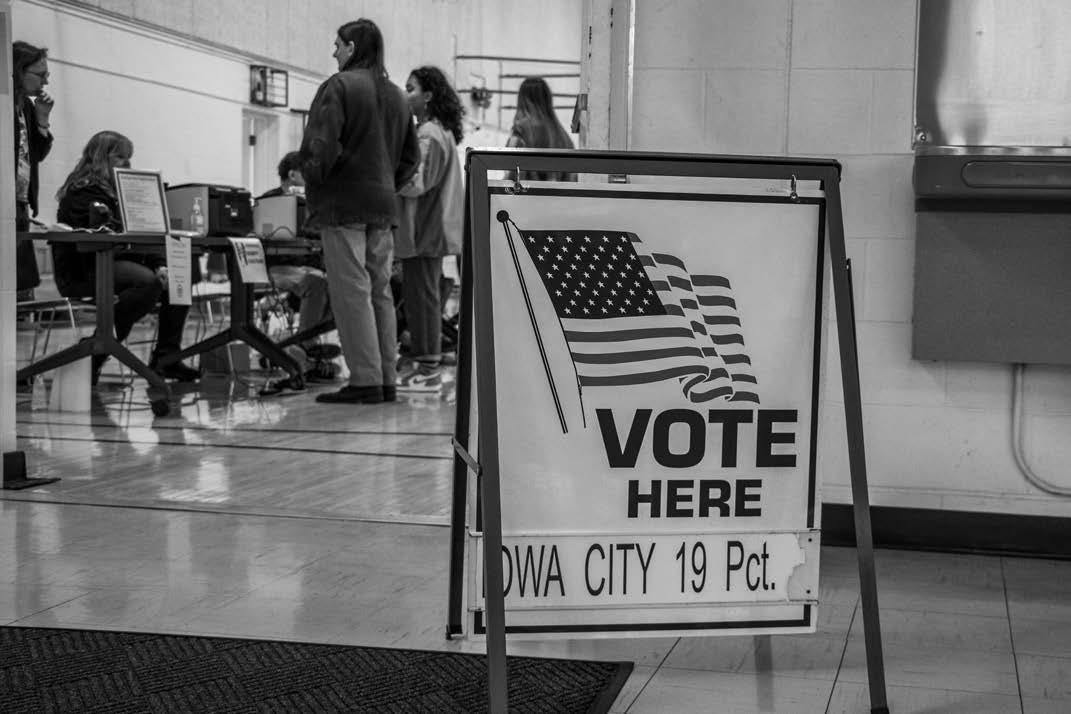
Iowans must request a mail-in ballot for each election and provide an eligible reason. Seems simple, right? Not exactly. As a student, I can’t tell you how many “inconsequential” tasks slip my mind. Sure, voting in a presidential election isn’t inconsequential — it’s incredibly consequential, especially given the current political landscape. That said, when something only happens every four years, it’s fair to assume some students will forget to request a ballot 15 days in advance.
As an Illinois native, this is all terribly confusing. Not only do Illinois’ voting laws differ from Iowa’s — and we’re only a state away — but they differ from those in every state.
In Illinois, no identification is required to vote in person. The state implemented automatic voter registration, also known as AVR, in 2017, which meant I registered to vote when I got my license.
For vote-by-mail, or absentee voting, I can request a ballot anywhere from three months to five days before the presidential election. I can vote in person up to 40 days before the election, no excuse needed. I can even sign up for permanent vote-by-mail.
Now, forget about students and think about groups who might encounter barriers when voting.
How do we accommodate non-English speakers? After all, the U.S. doesn’t have an official language. How do we make crowded polling locations worth the wait? In Georgia, that’s not a concern — the state made it a crime to provide water to voters waiting in line. What about people with children who don’t qualify for early voting?
Barriers to voting
To some of you, this probably reads like a load of bull. People should want to vote, and they should make accommodations to do so.
I agree — to an extent. Yes, people should want to vote. No, people shouldn’t have to jump through hoops to make that possible.
If someone feels disillusioned by the voting system or the candidates, how can we expect them to go the extra mile to vote? I don’t think we can.
In primary elections, which decide candidates, many states require voters to register with a political party. Those who refuse to affiliate often can’t vote for presidential nominees.
In some states, voters who don’t register a party preference can cast a crossover vote for the Democratic, Libertarian, or American Independent parties, but not the Republican or Green parties. Those require voters to re-register with their party.
Only 15 states have open primaries, meaning voters of any affiliation may vote in the primary election for any party. And still, all
primary systems — open, closed, and semi-closed — are subject to “sabotage.” Even a degree in political science might not make sense of what is so senseless. At least not for me, so I won’t attempt to here. What’s more concerning is that elected officials have made comments like, “We need to get back to 1958-style voting.”
Really, John Fillmore? This guy’s home state of Arizona had a literacy test in 1958 — a requirement we’ve done away with as a nation because, oh, wait, it’s racist and ableist. Need I remind everyone that 1958 also predates the Civil Rights Act and Voting Rights Act?
But sure, John Fillmore, let’s get back to a time when your election is guaranteed because the only people eligible to vote are those who look and think like you. No wonder he lost the 2022 Republican primary.
Not every Republican has echoed Fillmore’s comments, but many have shown they feel similarly.
Between Jan. 1 and May 3 this year, six Republican-led states enacted restrictive voting laws, citing concerns about mail-in voting fraud.
This is despite the fact that the Cybersecurity and Infrastructure Security Agency, a component of the Department of Homeland Security, said there was “no evidence that any voting system deleted or lost votes, changed votes or was in any way compromised” in the 2020 presidential election.
Like everything in life, language matters. Republicans have used this truth as a tactic to create more gray areas.
The new restrictive voting laws have been criticized for failing to clearly define their parameters. In Alabama, for example, it’s unclear if someone can be held criminally responsible for providing postage stamps to a neighbor distributing absentee ballot applications.
It’s hard to say — and even harder to argue — that wasn’t the intent of Republican lawmakers.
Where do we go from here?
Believe me, I know there’s more nuance to this than I’ve included. That’s the problem. Why is there so much complexity when it comes to voting in America? Shouldn’t the goal be to eliminate confusion and streamline the process so voter turnout reflects that?
Despite voter turnout soaring in recent years, the U.S. still ranks 31st against 49 other countries, sandwiched between Colombia and Greece for election turnout. Not exactly a high bar for a country that’s been defined as a “global superpower” and a “hero in the fight for democracy.”
In a country that prides itself on democracy, it’s time we make voting something every American can easily do — no excuses, no exceptions.
Jami Martin-Trainor | Executive Editor
Columnists: Muskan Mehta, Kennedy Lein, James McCurtis, Caden Bell, Cole Walker, Carson Hartzog, Darrell Washington, Jackson Mendoza, Abigail Jones, Reese Thompson
Jack Moore, Stella Shipman, Carson Hartzog, Charlie Hickman
Infographic by Emily Pavlik | The Daily Iowan
Grace Smith | The Daily Iowan
Iowa City residents vote at the Iowa City Community School District administration building on Dodge Street
during Election Day on Nov. 7, 2023. Iowa City residents voted for city and school board elections.
opening the restaurant soon. He said a lot of work needs to be done to fully install technology, equipment, and fixtures in the space once construction is completed. Additionally, health permits and liquor licenses require administrative work that take more time to get done.
Sam Gelman said he and the team working on Paper Crane are excited about opening the restaurant and building something both unique for Iowa City and distinct from their previous work at The Webster.
“We’re excited to bring a new concept, something different, to the northside,” he said.
Riene Gelman is currently more responsible for day-to-day issues at The Webster,
Sam Gelman said the orientation and training process for the new staff, including mock services, is the most important item, and that timing all these items is the necessary part of determining when the restaurant will open.
“We’re excited to bring a new concept, something different, to the northside .”
Sam Gelman The Webster’s co-owner anf chef
but her attention is split between The Webster and Paper Crane. She said she is excited to create something that is attractive to
more people, especially students, if Paper Crane’s early success allows them to open up for lunch in addition to dinner.
“I think it’d be a good spot for students coming back and forth to class or home to grab a bite,” she said.
Riene Gelman believes Paper Crane will be open to more than people looking for upscale meals or students who typically look for cheaper dining options.
“I think it’s a concept that, overarching, appeals to a larger swath of the population,” she said.
New partnership brings extra warmth to Iowa City
The Iowa City Police Department is teaming up for the first time with the Consultation of Religious Communities to provide winter clothing to the community.
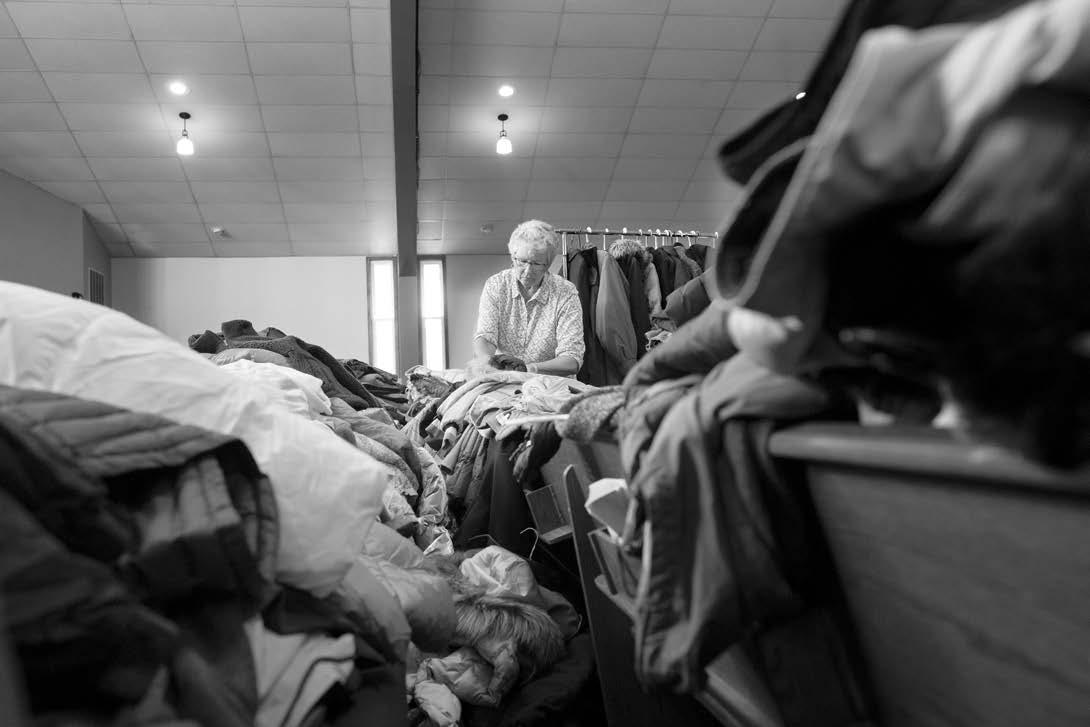
Communities
Religious Communities
Emma Jane News Reporter news@dailyiowan.com
For the first time, the Iowa City Police Department is partnering with the Consultation of Religious Communities for a winter clothing drive, combining their efforts to provide essential cold-weather gear to local residents as temperatures drop.
The Consultation of Religious Communities is an interfaith network of faith groups, social service agencies, and advocacy organizations dedicated to improving the quality of life and well-being for all individuals and families in Johnson County.
Iowa City Police Department Community Outreach Sergeant Kevin Bailey, a lead organizer of the initiative, said the
feedback from local kids who receive coats makes the effort leading up to distribution days all the more meaningful.
“Kids would tell us, ‘I wouldn’t have a coat, I would be wearing my same coat that had stains or rips in it had it not been for this event,’” Bailey said.
Tre Hall, Iowa City Police Department community outreach assistant, added that while the initiative focuses on providing coats for kids, the department recognizes that adults also need adequate clothing this winter.
“You’ve got people who work a manual labor job that they have to go outside for, but they’ve got a coat that has holes in it,” Hall said. “They’ll be able to get coats. Everybody deserves to be warm in the winter.”
Last year, without the involvement of the
Consultation of Religious Communities, the Iowa City Police Department received and distributed 1,200 donated coats as well as thousands of other articles of winter clothing in sizes ranging from newborn to adult, Hall said.
John Barr, a leadership team member for the Consultation of Religious Communities, said their annual winter clothing drive, which has been running for over two decades, distributed around 1,300 coats to over 300 families last year.
By partnering for this year’s initiative, the Iowa City Police Department and the Consultation of Religious Communities aim to combine their strengths — the department’s ability to gather donations and the Consultation of Religious Communities’ organizational expertise — to make an even
bigger impact on the community.
“This is kind of a new adventure for both of our groups,” Barr said. “It really looks like a win-win situation.”
Iowa City Police Department Public Information Officer Lee Hermiston, who has been involved in the past four years’ clothing drives, said the department is always looking to enhance its efforts and reach more people with each year’s drive.
“It’s all about improving,” Hermiston said. “Ultimately, we just want to make sure that people have the clothing they need this winter and can feel safe and comfortable.”
Hermiston also emphasized the personal dedication Bailey and Hall bring to the initiative, noting that they wash and organize the donated items in their own machines and that both of their families volunteered during last year’s drive.
“There is so much work that goes in behind the scenes. And just that level of care — you can’t teach that. You can’t train that,” Hermiston said. “I feel like that comes from a place of being very committed.”
Barr noted that the drive fills a unique need in the community, particularly for newcomers unfamiliar with Iowa’s harsh winters. With nearly 10 percent of Iowa City residents born outside the U.S., the initiative ensure everyone is equipped to handle the cold.
“We’re knowledgeable that we have people that have moved to the community who have never experienced winter before and are going to be in desperate need of clothing,” Barr said.
He also emphasized that distribution relies heavily on volunteer support, with volunteers not only helping to facilitate the events but also connecting with participants and offering helpful recommendations on winter gear selection.
Barr encouraged anyone interested to sign up as a volunteer, noting that the organization often attracts college students to assist.
The winter clothing distribution events will take place at River Community Church from 9 a.m. to 6 p.m. on Oct. 16 - 18 and from 9 a.m. to noon on Oct. 19. Online registration is required beforehand, though two drop-in slots will be available each halfhour.
For health and safety, only one representative per family is allowed to attend, with seven adult shoppers admitted every 30 minutes. Participants are asked to wear masks and arrange for childcare while they shop.
Cyclists catch air on new Iowa city bike trail
The new bike trail was completed in August and is now open at Terrell Mill Park.
Madison Schuler
News Reporter news@dailyiowan.com
Iowa City’s Parks and Recreation Department opened a new Ice House Single Track Trail located at Terrell Mill Park.
The bike track trail was officially ready for public use on Aug. 14, and it includes beginner and intermediate routes with features around the old Englert Ice House foundation. The trail also connects to the Iowa River Trail and other local routes to make it easily accessible for cyclists.
Iowa City Parks and Forestry Superintendent Tyler Baird said the trail fills a gap in Iowa City’s outdoor recreation offerings, catering to various age groups.
“[The trail] is something that we had envisioned and hoped for for quite a while and the bicycle community had been asking for,” Baird said. “We happened to find the right spot for it finally.”
The process involved years of consideration and planning to find the optimal location within the park system, he said.
The design and build of the trail were done in-house by the city staff, with some expertise sought from the superintendent of parks at Coralville, as Coralville has had single-track trails for some time. Staff then walked the site, picked a route, and created a GPS-style map for the build crew to follow. The crew made the necessary adjustments on-site and rode segments of the trail to ensure it felt right for biking.
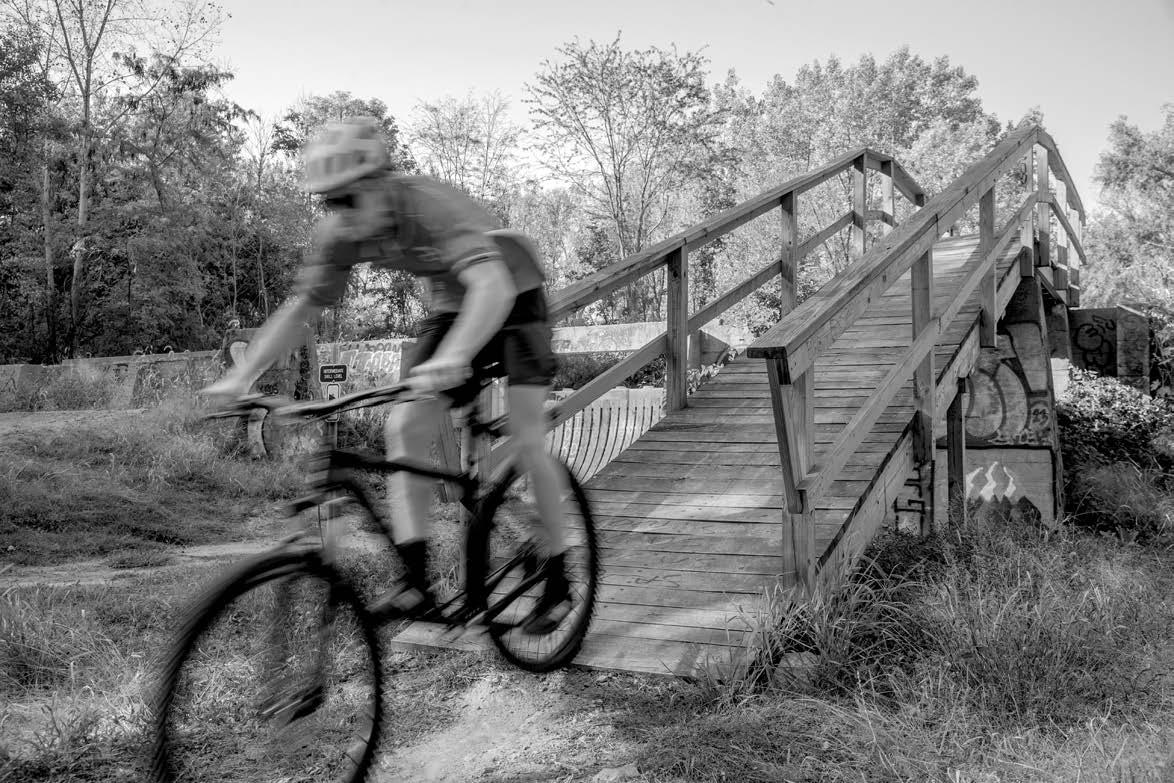
In addition, Baird shared that the wooden features around the Ice House Single Track Trail were created using Iowa City lumber.
“A lot of the wood with the decking on the built features came from lumber from trees that we took down around town that needed to come down, and we were able to reuse that,” Baird said. “So, it was a fun feature of the trail, reusing some of our urban lumber to put it to a nice use and create some amenities.” Ryan Baker, owner of World of Bikes, was excited for the long-awaited trail.
“It’ll be a bonus to some of the great trails that we already have in place and hopefully give some accessibility to people that may not be able to get out to some of the other trail systems in the area,” Baker said. Baker and his family also donated to the Ice House Single Track Trail in honor of his late father.
“We had gotten a considerable amount of money through donations through his memorial,” Baker said. “We decided that when the Parks Department was going to put this in, we would offer to pay for the bench and workstation at the trailhead in his memory.” Baker also believes the trail is a bonus to the current trail network that will offer new opportunities for outdoor recreation.
Matt Burkey, the Iowa Bicycle Coalition’s Safe Routes to School coordinator, discussed the Ice House Single Track Trail’s role in making Johnson County a destination for mountain biking, tourism, and making the community more livable.
“When people travel to try mountain
bike trails, it’s great to have many different options nearby,” Burkey said. “With the Ice House, Carol Mill Park in Iowa City, Woodpecker and Creekside mountain bike trails in Coralville, and Sugar Bottom trails up north in Johnson County, it makes a really great opportunity to boost tourism and make Johnson County a more livable community.” The Ice House Single Track Trail will also allow residents to have an opportunity to use mountain bike trails locally, Burkey said. In addition, Burkey said the Iowa Bicycle Coalition’s mission is to ensure that bicycling in Iowa is safe, enjoyable, and accessible for all. One important upcom -
ing event is the National Walk & Roll to School Day. The event is an opportunity to promote active transportation to schools and get more kids and families walking and biking together instead of driving to school. In the future, Iowa City’s Parks and Recreation Department hopes to create more opportunities for cyclists in the community, and the new trail has already begun receiving positive feedback.
“We’ve had some emails from people who have used it that have expressed how much they appreciate having a place in Iowa City where they can go,” Baird said. “It’s just a cool space to do some single-track or off-road biking right in town.”
Isabella Tisdale | The Daily Iowan
Diana Helling marks a size for a coat for a clothing drive at River Community Church in Iowa City on Oct. 14. The Consultation of Religious
partnered with the Iowa City Police Department to host a clothing drive with winter coats. Helling joined the Consultation of
form her home church, St. Thomas Moore.
Photo illustration at Ice
The program identifies these “high-risk” individuals through communication efforts with Johnson County residents, inviting those with concerns to voice them to the program.
County Attorney Rachel Zimmermann Smith said the program doesn’t follow a strict criteria for identifying high-risk individuals.
She said decisions operate on a case-by-case basis, citing instances where residents are invited to report concerning behavior indicative of further violence.
High-risk individuals “may be engaging in behaviors in the community that indicates that they may be participating in community violence, whether that’s engaging on social media with showing weapons, whether that’s being in areas where there have been fights reported, or shots fired reported,” she said.
Once a report is validated and verified, CVI
members can take action to provide outreach and help.
Lang explained that high-risk individuals will be given a needs assess -
“It’s good when you have collaboration with law enforcement and the community all trying to solve this problem.”
Jessica Lang Community Violence Intervention coordinator
ment to uncover what barriers or needs are drawing people into violence in the community.
Barriers could range from mental health, substance abuse, transportation issues, or food shortages.
A young person could also be given a needs assessment for potential factors such as struggling in school or lack of a 504 or IEP plan.
“We essentially have a very authentic and genuine conversation to figure out what some frustra -
tions and struggles are that they’re having, and then we go from there,” Lang said. “To figure out how to get them to where they want to be and where they need to be in order to not participate in the activities that they’re involved in.”
Lang emphasized the importance of building trust with those whom the program interacts.
“This is a long-term kind of relationship that we build, and it is constant follow up, constant check in, constantly letting them know where things are,” she said. “You have to build trust, and you have to build rapport.”
In order to measure the program’s effect on com -
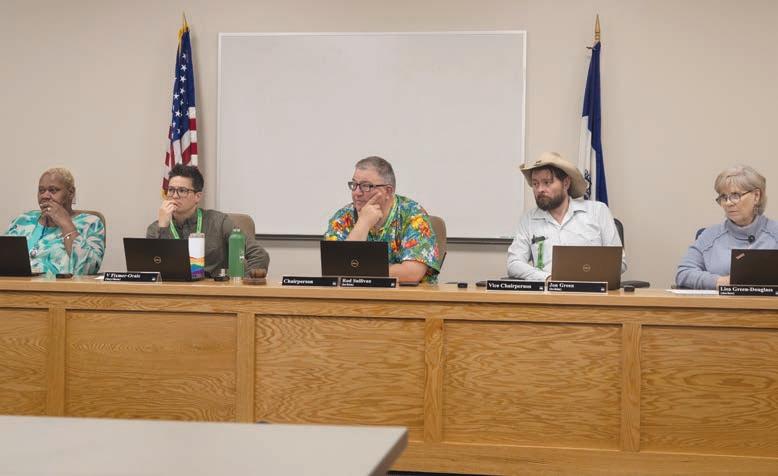


AMANDA JONES
In That Librarian, Amanda Jones maps the book
banning crisis occurring all across the nation, drawing the battle lines in the war against equity and inclusion.
October 19, 10am
Meeting Room A Iowa City Public Library

Featuring:
202 2 2024
munal violence reduction, CVI is working with the University of Iowa Center for Social Science Innovation to collect data and measure the program’s success.
The program also works closely with law enforcement, both in identifying high-risk individuals and strategizing outreach methods for them in monthly law enforcement work group meetings.
Iowa City Police Department’s Sergeant Matthew Ties said while gun violence and community violence as a whole has declined over the years in Iowa City, the program is still needed to provide those same results across the county.
“It’s good when you have collaboration with law enforcement and the community all trying to solve this problem,” he said. “I foresee it being a great thing for this community.”
While funding is secured for the next two years from ARPA and the county, program coordinators are looking to explore other sources, such as grants or partnerships with neighborhood centers.



LITERARY LEGENDS: TRACY KIDDER
Tracy Kidder reflects on his lengthy literary career and reads from some of his bestselling work. The Pulitzer Prize winner will be in conversation with fellow Iowa Writers’ Workshop alum Stuart Dybek.
October 15, 7:30pm Iowa Memorial Union Main Lounge
FORREST GANDER
Pulitzer Prize-winning poet Gander’s new novel-poem, Mojave Ghost, takes readers to his birthplace in the Mojave Desert and his current northern California home, where tumultuous memories coalesce with the present.
October 19, 1:30pm Prairie Lights Books

JENNIFER CROFT Award winning literary translator Jennifer Croft’s debut novel, The Extinction of Irena Rey is a hilarious, thought-provoking tale that is a brilliant examination of art, celebrity, the natural world, and the power of language.
October 19, 10:30am Prairie Lights Books
ARI BERMAN Berman, the national voting rights correspondent for Mother Jones, will present Minority Rule: The Right-Wing Attack on the Will of the People—and the Fight to Resist It.
October 19, 2:30pm Meeting Room A Iowa City Public Library


Emma Calabro | The Daily Iowan
Members of the Johnson County Board of Supervisors meet at the Johnson County Public Health and Clinical Services building on April 24.
Pope’s comments divide Iowa City Catholics
Pope Francis called on Catholics to vote for “the lesser of two evils” come Nov. 5.
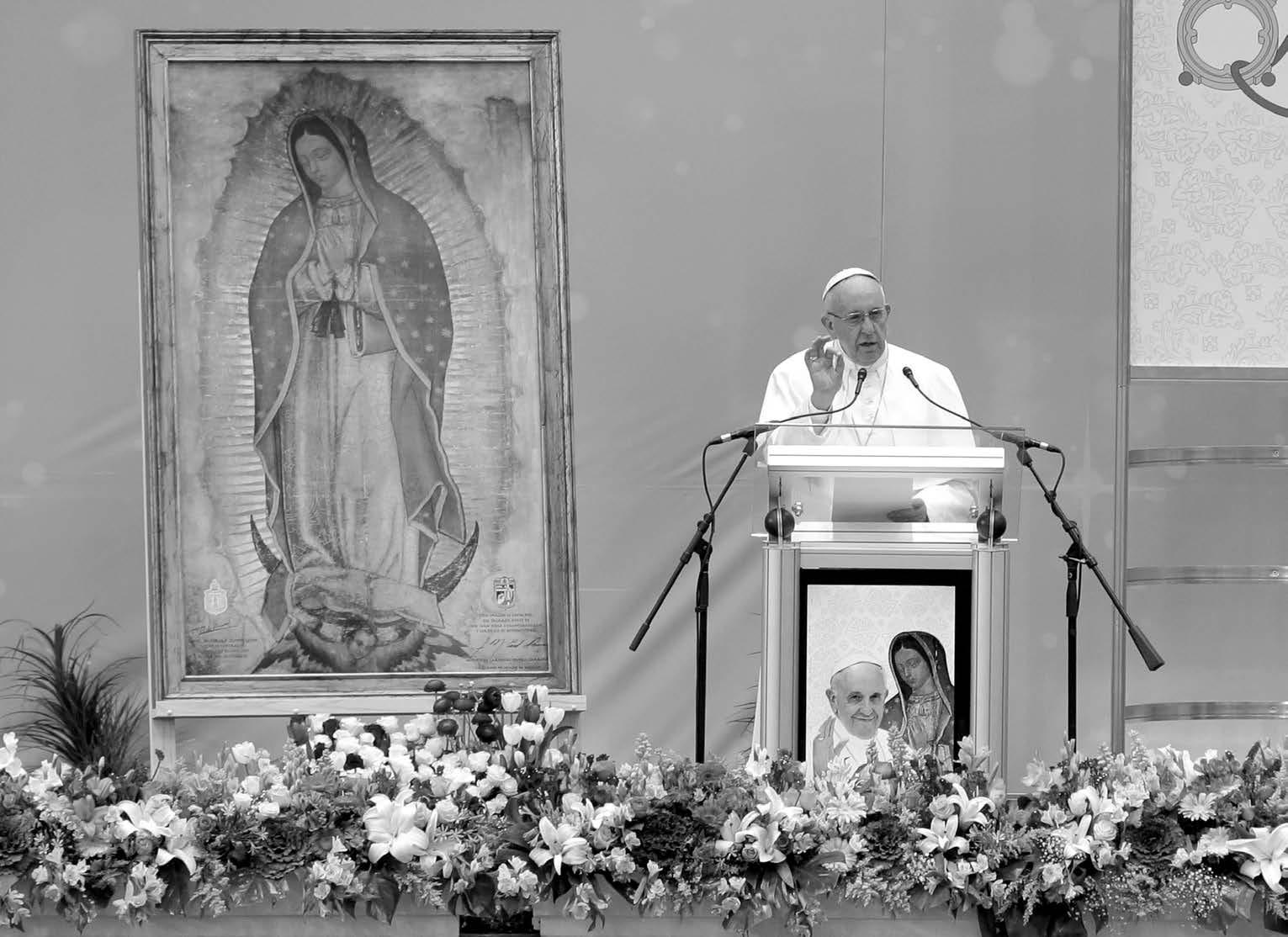
Mia O’Connor-Walker Politics Reporter politics@dailyiowan.com
Iowa City Catholics are divided on who they will vote for in the presidential election after Pope Francis told U.S. Catholics to vote for “the lesser of two evils.” He condemned both presidential candidates for being against life due to their stances on abortion and immigration.
The pope did not specify which candidate he preferred but rather emphasized that both former President Donald Trump and Vice President Kamala Harris do not uphold Catholic values.
“Both are anti-life. Both the one who throws out migrants and the one who kills babies. Both of them are against life,” Pope Francis said.
Pope Francis’s comments referred to Harris’s pro-choice platform on abortion and Trump’s stance on migration and border control. The pope did not say which of these policies was more problematic and said the decision would lie in the hands of the American people. He also urged every American to exercise their right to vote.
Christians are by far the largest religious group in Iowa, making up 77 percent of the state’s religious population. Within this group, Catholics make up 18 percent. A historically unpredictable voting bloc, Catholics are evenly divided between Democrats and Republicans and have swung between the two parties during recent elections.
Given the split, Catholics are an unknown quantity in this upcoming election. Yet, Pope Francis wants them to vote.
Iowa City Catholics, too, are divided on the issue. Reporting from The Daily Iowan suggests many who attend local parishes are still undecided in light of the pope’s guidance.
Rev. Jeff Belger, the priest director of the Newman Center at the University of Iowa, described Pope Francis’s remarks as blunt but truthful.
Belger said the comments reflect the values of the church but also said that when making a moral decision, one must understand that some things are intrinsically evil while others are more nuanced, and their morality can be debated.
“His comment was, I think, oversimplified, by just saying they are both anti-life,” Belger said.
Belger also said he is frustrated at the lack of pastoral direction these comments provided. While emphasizing that the Catholic church is very pro-immigrant, he said that the U.S. bishops have already expressed that the abortion issue should take priority.
“It’s frustrating that he said it in that context, because the bishops of the United States have made a clear statement that the abortion issue is the pre-eminent issue of dealing with evil in our country,” Belger said.
Belger said he doesn’t affiliate with either party but rather votes based on issues that he sees as holding the greatest importance, which, for him, is abortion.
Belger acknowledges that no candidate is perfect. So, when he tries to come to a decision based on policy, Belger said he must assess issues where compromise can be found. Belger said compromise is possible on issues that are more subjective, such as the best approaches to handling immigration, but
compromise is not possible on moral issues like abortion. These moral issues, Belger said, should guide voters in their decisions.
“I feel confident in how I’m making my decisions because I look at what’s most important,” Belger said. “If only certain people in the country have rights, then we’re all sunk. But if we all have rights that we build on, then there’s a possibility of peace, and at least not violence against any particular segment of society.”
Brothers Mike and Joe Stein are similar in many ways. Both are track and field athletes at the UI, both are majoring in enterprise leadership, and both are planning on voting based on their strongly held Catholic faith. Over coffee and donuts in the St. Wenceslaus Catholic Church basement, the brothers agreed that while they support the pope, they take issue with his decision to equate Harris and Trump.
Mike Stein said he doesn’t believe the pope’s comments reflect the values of the Catholic church, and that the pope should reconsider his stance on migration.
“I love Pope Francis, but I think it’s wrong for him to be pushing migration,” Mike Stein said, as his brother Joe nodded his head in agreement.
The abortion issue takes precedence with both of the brothers, and both Joe and Mike see Trump as the more pro-life candidate. They cite Trump’s nominations of Supreme Court Justices Neil Gorsuch, Amy Coney Barrett, and Brett Kavanaugh as evidence. All three of these Justices voted to overturn Roe v. Wade in 2022, which eliminated the constitutional right to abortion.
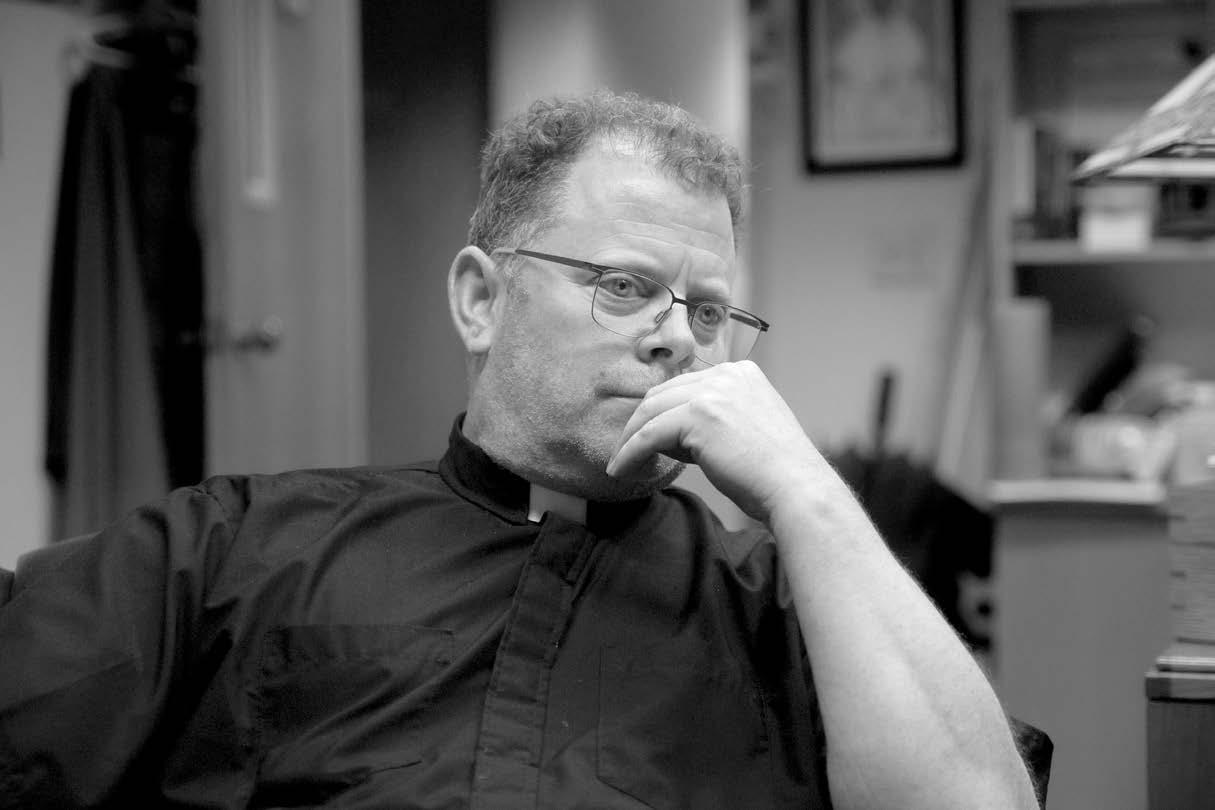
Neither brother views the Democratic Party as respecting Catholic values, citing the party’s policies on abortion, gender-affirming surgery, same-sex marriage, and immigration. Therefore, they said voting for Harris isn’t an option.
“I don’t think you can be left-wing and Catholic anymore,” Mike Stein said.
A research study by Sacred Heart University estimated that in the past fifteen presidential elections, Democrats had won the Catholic vote eight times versus Republicans who have won seven times.
The latest Pew Research Center survey found that 52 percent of Catholic registered voters would vote for Trump if the election were held today, and 47 percent would vote for Harris. Ultimately, though, the brothers do agree with the pope’s comment to vote for the lesser evil.
“We have a duty to vote for the lesser of two evils,” Joe Stein said. “You have to just vote for the lesser of two evils in order to have a prosperous society and a moral society.”
James Allbright, a UI senior majoring in statistics, provides a different perspective on the election by trying to find the balance between his pro-life and pro-migration beliefs and the perceived shortcomings of each candidate.
Allbright has been involved with the Newman Catholic Center since his freshman year and is a current fellow, responsible for planning retreats and leading Bible study.
Allbright agrees with the pope’s comments but thinks that the pope could have clarified whether he was describing the candidates themselves as evil or just their actions.
“I truly believe that he’s calling their actions evil because all Catholics hold the belief that no one truly is evil,” Allbright said.
Allbright said the pope’s comments encouraged him to dive deeper into the two candidates’ policies, particularly regarding abortion and immigration, and to discover what policies align best with his Catholic beliefs.
When looking at these policies, Allbright agreed with the pope that both candidates fall short of the Catholic pro-life belief. Allbright’s largest criticism of Harris is her stance on abortion, which, in Allbright’s opinion, permits the killing of those who cannot stand up for themselves. However, Allbright said he doesn’t think that Trump is innocent in this regard, either.
“He’s for the death penalty,” Allbright said. “He’s also against allowing immigration, which is a very important topic for Catholics. We should welcome all people, and we should love them and care for them if they need.”
Allbright said, at first, he was unsure if he wanted to vote. He doesn’t particularly like either candidate, and neither Trump nor Harris align with his beliefs as a Catholic. However, after a conversation with his mother in which she expressed the need to vote as a means to stand up for their beliefs, Allbright decided to vote.
He intends to reconcile with each candidate’s shortcomings by using his statistics major and trying to assess which policies are most likely to be passed — and taking it from there.
As a faith-based voter, Allbright said he will be voting to advocate for his beliefs of promoting goodness, alleviating suffering, and helping those who struggle.
“I think we have a duty to go actually vote and advocate for the beliefs that we so strongly hold and profess,” Allbright said.
Hannah Neuville | The Daily Iowan
Rev. Jeff Belger, priest director of the Newman Catholic Student Center in Iowa City, is seen on Sept. 25. Belger spoke to The Daily Iowan about feelings towards the Pope’s recent comments. regarding the upcoming election
Mark Lambie | El Paso Times via USA TODAY NETWORK
Feb 17, 2016; Ciudad Juarez, MEXICO; Pope Francis speaks to Juarez business leaders and laborers at Colegio de Bachilleres del Estado de Chihuahua.
COAST-TO-COAST FAN BASE
The Big Ten opener for Iowa on Oct. 12 hosted more Husky fans than originally anticipated, and the tailgate culture was as strong as ever across Iowa City.
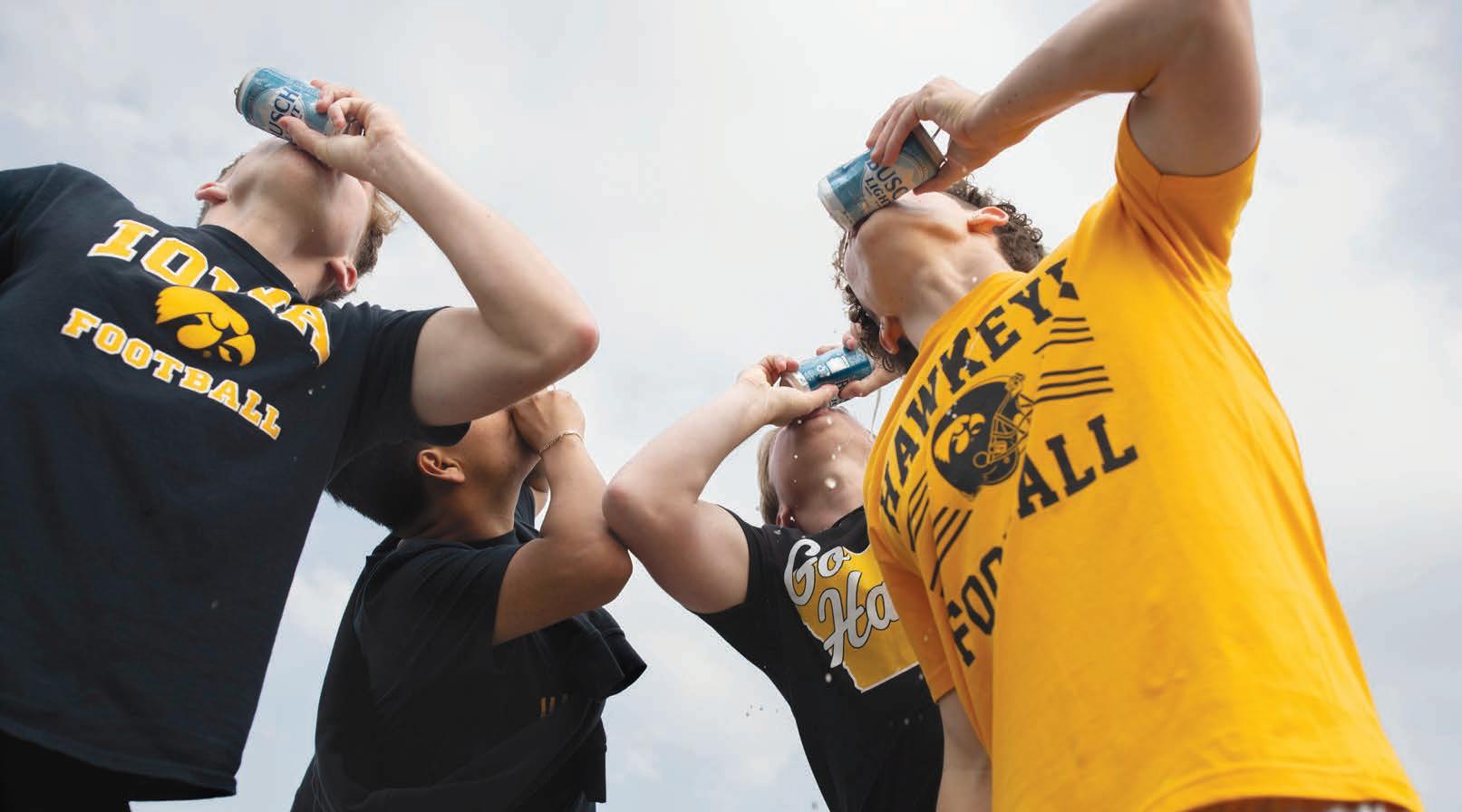
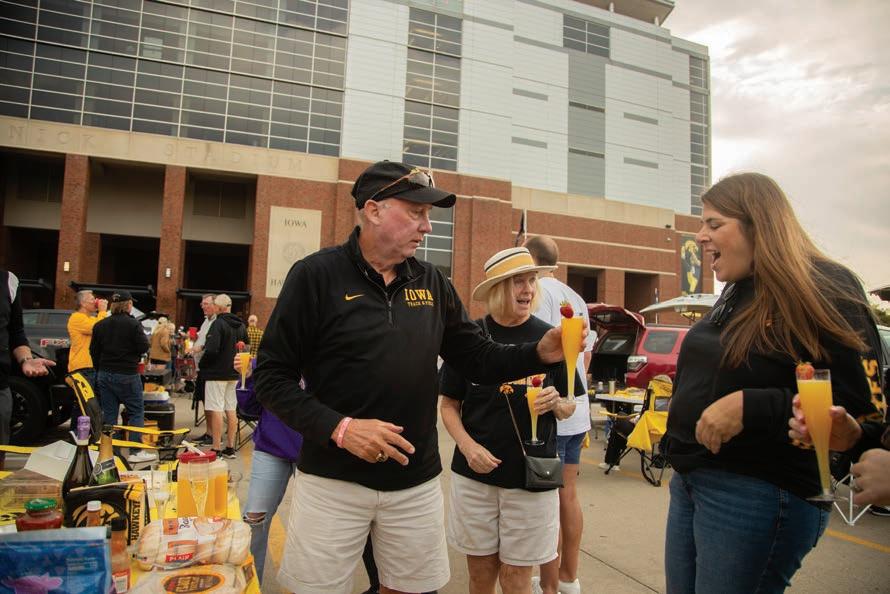



Isabella Tisdale and Emma Calabro | The Daily Iowan
(Above) Iowa fans shotgun beers at a tailgate before a football game between Washington and Iowa at Kinnick Stadium in Iowa City on Oct. 12. The Hawkeyes defeated the Huskies, 40-16. (Right) Randy and Molly Rohlfsen play putt poker before a football game between Washington and Iowa at Kinnick Stadium in Iowa City on Oct. 12. The Rohlfsens invented the game and had the board made for tailgating. (Below Right) A Washington fan grabs food at a tailgate before a football game between Washington and Iowa at Kinnick Stadium in Iowa City on Oct. 12. Fans from Washington joined the Iowa tailgate. (Below) Iowa fans drink mimosas before a football game between Iowa and Washington at Kinnick Stadium in Iowa City on Oct. 12. The group made mimosas at a tailgating spot in front of Kinnick for the hours before the game. (Bottom) Fans take shots at a tailgate before a football game between Washington and Iowa at Kinnick Stadium in Iowa City on Oct. 12. Many of the Washington fans traveled 1,863 miles to make it to Kinnick Stadium.

Iowa enshrines rich sporting history
The Hawkeye Histories exhibit tells the tale of pivotal moments on Iowa sports.
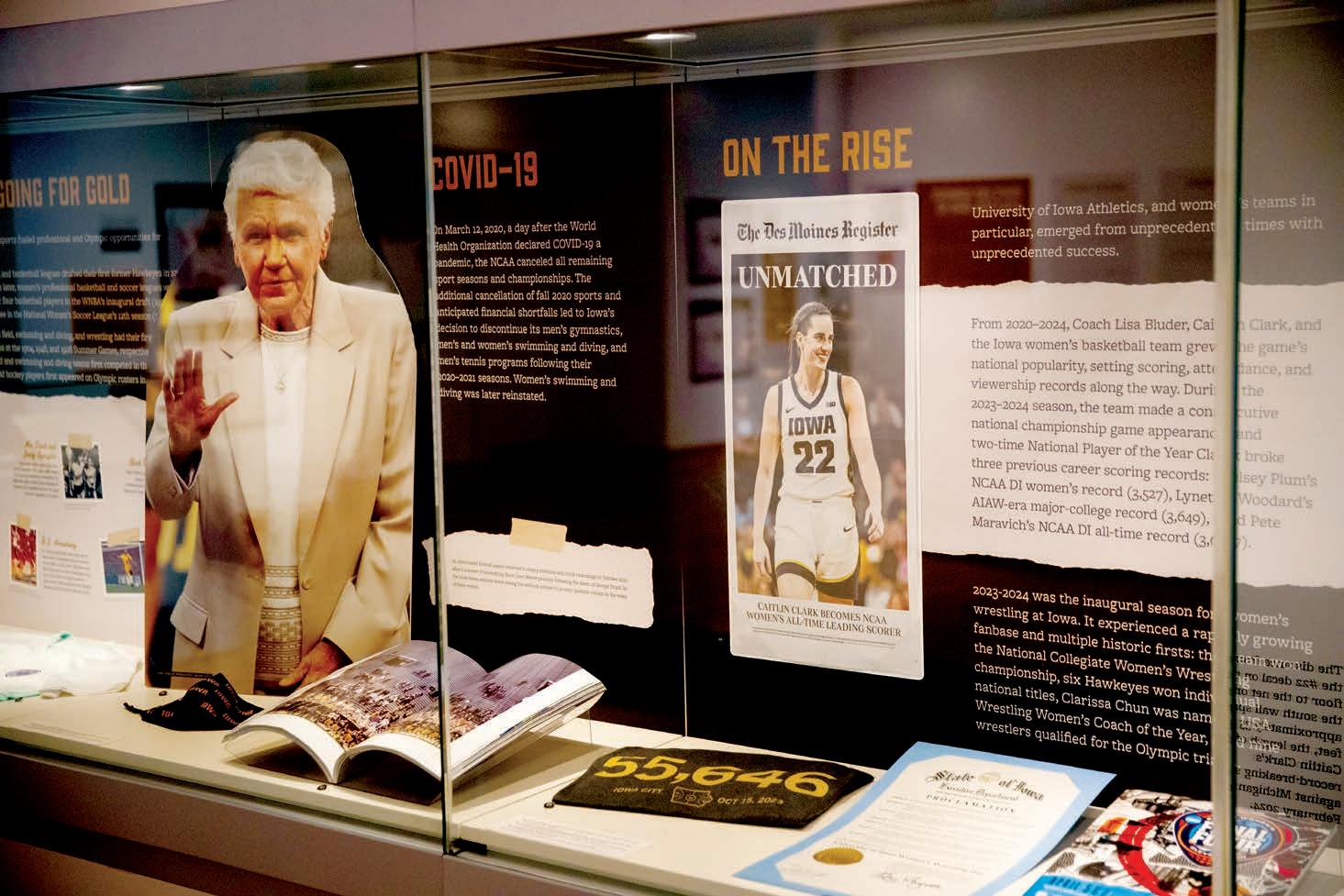
The Hawkeye Histories gallery is seen in the University of Iowa Main Library on Aug. 26. The gallery showcases items from important moments in Iowa athletics history.
Chris Meglio Pregame Reporter sports@dailyiowan.com
Students, faculty, Iowa City residents, and Hawkeye fans alike have been privileged to witness some great Iowa college athletes throughout past years, including Caitlin Clark, Cooper DeJean, and Spencer Lee. But what about those prior? What about the previous athletes who helped shape the culture of Iowa sports way back when?
University of Iowa Associate Professor of Instruction of Sport and Media Culture Jennifer Sterling and Exhibition and Engagement Coordinator Sara Pinkham
FIELD HOCKEY
put together the “Hawkeye Histories, Sporting Stories” exhibit, displaying many pivotal events across all Iowa sports dating back to the early 1900s.
The exhibit has been sitting in the Main Library Gallery near the east entrance since Aug. 26 and will stay open until Dec. 19.
“I just kind of wanted to bring a more comprehensive… more representative history to light and just have people have a little bit of knowledge about all these really unique things to Iowa,” Sterling said. “Iowa was really involved in a lot of the major shifts in intercollegiate athletics.”
Sterling leads many courses that teach students about the history of sports, such as Inequality in American Sport and Sport
and Globalization. It was only some years ago when she came up with the idea for an Iowa sports history exhibit.
She spent a great amount of time doing extensive research on the history of Hawkeye athletics, digging up any new information she could find.
“The first major step was getting into the archives and doing research,” Sterling said. “I researched across the university archives and the Iowa women’s archives and then the Iowa Digital Library. One of the first things I did was literally flip page by page through each of the yearbooks just to get an idea of the timeline to start collecting images that moved me in particular ways.”
For an exhibit to be displayed in the Main
Iowa field hockey third-year defender emerges as a leader
Milly Short has logged the second-most minutes on the team roster during the 2024-25 season.
Library Gallery, the exhibition curator puts in a proposal to a committee that consists of representatives from the Stanley Museum of Art and the Pentacrest Museums — typically a few years prior.
A unanimous decision must take place for the exhibit to be approved. Sterling gathered enough information to earn unanimous support from the committee.
“The main point of the Main Library Gallery is to be able to show off the things that we have in our collections here at the libraries within the context of the story,” Pinkham said. “We went into production about a year and a half ago … That’s where
Moving
forward with the Iowa women’s basketball team

Coming off a landmark season, the Hawkeyes return to the court with new leadership.
Jack Birmingham Sports Reporter sports@dailyiowan.com
The Iowa women’s basketball team is poised to enter the 2024-25 campaign anew after a legendary season that saw tremendous strides for both the school and the sport as a whole.
In the 2023-24 season, head coach Lisa Bluder and deep shooter Caitlin Clark sensationalized women’s basketball accorss the country, The team scored 91 points per game, played in front of sold-out crowds at Carver-Hawkeye Arena and reached the NCAA championship game against South Carolina. But with these two key components having moved on from Iowa basketball — Bluder to retirement and Clark to the WNBA — the Hawkeyes are looking to keep the ball rolling and the momentum alive with a new team in the new season. Head coach Jan Jensen, in her first year in the position, acknowledged that last year’s class was both rare and special — especially with the leadership of Clark, now playing for the Indiana Fever, and Kate Martin, now with the Las Vegas Aces.
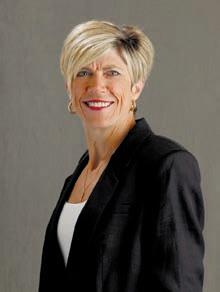
Milly Short, a versatile athlete who is in her second consecutive season starting for Cellucci’s defense.
“Last spring we identified a handful of people that had great influence on the team and great credibility,” Cellucci said. “We really needed to challenge them to use their words. [Short] has just always led by her actions, but we needed her to be a better verbal communicator and address difficult situations.”
Short’s collegiate career was in jeopardy before it even started three years ago, with her initial plan revolving around medicine and not field hockey. She eventually decided to play for Cellucci and Iowa but was met with
“Any time you lose a very senior-heavy class, there’s just a gap for a while,” Jensen said. “I don’t care how great that freshman class coming in is; there’s no speedy trick for experience. You just have to go through it. You just have to fall on your face a few times. You have to make a few mistakes, get some glorious moments.”
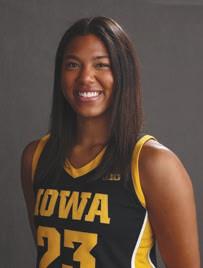
Third-year Jada Gyamfi agreed the graduating class brought a lot to the team but remains excited for the upcoming 2024-25 campaign.
“I think it’s really exciting,” Gyamfi said. “Obviously, there’s room for more opportunities, for more players. We miss Caitlin and all those guys. They brought a lot to the team, but I think we have some really good new additions. We’re just excited.”
One such addition is Lucy Olsen, a score-heavy guard who transferred from Villanova, finishing third in the NCAA in scoring last season with 23.3 points per game.
Ryan Paris | The Daily Iowan
Cody Blissett | The Daily Iowan
Iowa defender Milly Short hits the ball during a field hockey exhibition match between Iowa and Northwestern
Football
Saturday, Oct. 19
Michigan State East Lansing, Michigan
6:30 p.m.
Soccer
Thursday, Oct. 17
Washington Iowa City, Iowa
7:30 p.m.
Sunday, Oct. 20
Oregon Iowa City, Iowa
1 p.m.
Volleyball
Wednesday, Oct. 16 Northwestern Evanston, Illinois
8 p.m.
Field Hockey
Friday, Oct. 18
UC Davis Iowa City, Iowa 3 p.m.
Swimming and Diving
Men’s Cross Country
Friday, Oct. 11 Bradley Pink Classic Peoria, Illinois
1:30 p.m.
Saturday, Oct. 19
Pre-National Meet
Rowing Saturday, Oct. 19
a.m.
WHAT YOU’VE MISSED
Iowa football wide receiver Kaleb Brown and running back Leshon Williams both announced on Oct. 7 that they will be taking their redshirt years and will not play any more games for the Hawkeyes in 2024.
“I wish my teammates the best of luck this season and hope for the continued success of the program,” Brown said in a post on his Instagram page.
“Hawkeye nation, I appreciate the love and support throughout my time in the Black and Gold, and with the countless moments of excitement on the field, you’ve made every game unforgettable,” Williams wrote in an Instagram post.
Despite preseason hype, Williams fell on the depth chart as teammate Kaleb Johnson has earned almost half of the team’s rushing attempts in 2024. Williams is tied for fifth on the team in rushing yards with 21 on 11 carries, coupled with four receptions for 26 yards. He missed Iowa’s Week 4 contest against Minnesota due to injury and did not see action on Saturday against Ohio State. Brown was expected to play a major role in the new-look Hawkeye offense under offensive coordinator Tim Lester in 2024 but was arrested and charged with an OWI on June 24, causing head coach Kirk Ferentz to suspend him for the season-opener against Illinois State. Brown has also been battling an undisclosed injury throughout much of the season and has seen action in only one game, totaling 18 yards on his lone catch against Troy on Sept. 14.
QUOTE OF THE WEEK
Can the Hawkeyes conquer Sparta?
Assistant Sports Editor Brad Schultz takes a deeper look at Iowa’s upcoming opponent in the the Michigan State Spartans.
Brad Schultz Assistant Sports Editor brad.schultz@dailyiowan.com
Following a dominant win over Washington last weekend, the Iowa football team sits at 4-2 overall and 2-1 in Big Ten play at the halfway point of the season.
Now, the Hawkeyes turn their attention to a road contest against Michigan State, who enters the matchup with a pedestrian 3-3 overall record and 1-2 in Big Ten play under new head coach Jonathan Smith.
The Spartans had great success under head coach
Mark Dantonio in the 2010s but dealt with struggles both on and off the field under former coach Mel Tucker, who was fired in the middle of the 2023 season.
Smith previously served as the head coach of his alma mater Oregon State for six seasons and revitalized the struggling program, leading them to a 34-35 overall record and three consecutive winning seasons.
Smith seemed like a lock to stay in Corvallis for the remainder of his coaching career, but the demise of the Pac-12 left too much uncertainty surrounding the future of the Beaver program, so Michigan State swooped in and hired him following the 2023 regular season.
The Spartans haven’t produced the results their rabid fanbase expected them to reach under Smith in 2024, but the team still presents a difficult matchup for Iowa.
This marks the first trip to Spartan Stadium for the Hawkeyes since 2017, which resulted in a 17-10 Michigan State victory. The game will be televised in prime time with kickoff set for 6:30 p.m. CT on NBC. To fully digest this matchup, let’s take a deeper look at the Spartans.
moves in the offseason was sophomore quarter back Aidan Chiles, who spent his freshman cam paign as a backup to DJ Uiagalelei at Oregon State.
Chiles was a highly tout ed recruit out of Downey High School in California and was named a four-star recruit by 247Sports.
over to Michigan State to compete for the starting quarterback job in 2024 and earned the nod just a few days before the sea son-opener against Florida Atlantic on Aug. 30.
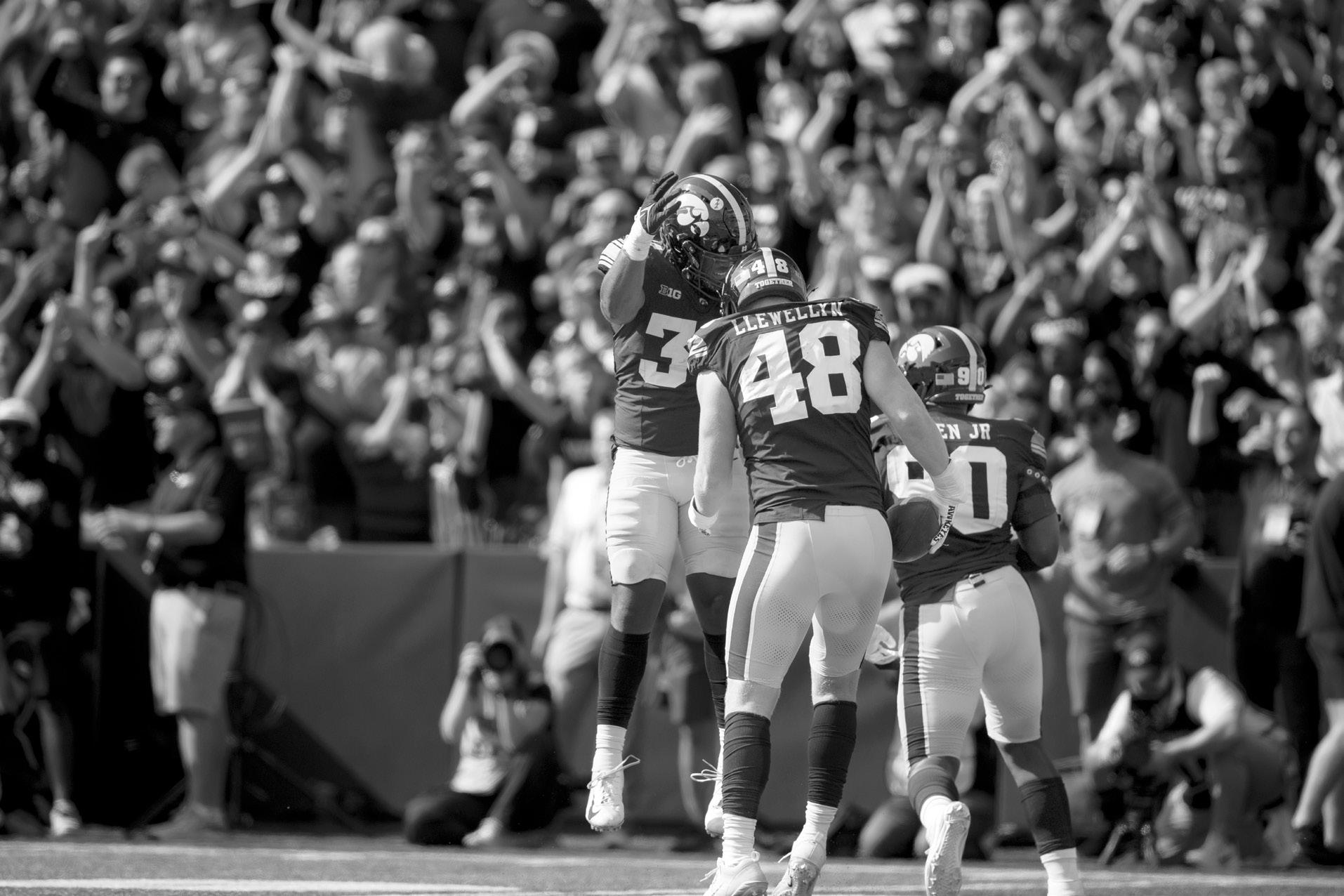
tions, the 19-year-old Chil es has struggled to adjust to college football, tossing five touchdowns and eight interceptions. Turnovers have been a major issue for Chiles through the first six games, as he has lost three fumbles in addition to the eight picks.
The Spartans enter this game fresh off a bye week after being demolished by Oregon, giving Chiles time to prepare and reset before facing a tough Iowa defense.
If Chiles can get his turnover problems under control, he has a solid supporting cast of wide receivers to throw to.
Nick Marsh, Montorie Foster Jr., and Jaron Glover have all recorded touchdowns and over 150 yards receiving, while tight end Jack Velling has chipped in over 200 yards and 19 receptions of his own so far.
The run game has been solid, with Kay’ron Lynch-Adams leading the charge with 338 yards and two touchdowns on 67 carries. Nate Carter follows close behind with 245 yards and one touchdown on 58 carries.
Q&A | ALEX WESNESKI
Chiles is also a prolific rusher, tallying 115 yards and three touchdowns on 45 carries. The Hawkeyes have historically struggled to stop dual-threat quarterbacks, so watch out for Chiles in this one.
Defense
Michigan State has allowed 21 points per contest and leads the Big Ten in total tackles with 379. The Spartans have also been strong in the secondary, collecting seven interceptions the fourth-most in the league.
Joe Rossi enters his first season as the defensive coordinator following seven seasons at Minnesota under P.J. Fleck, spending five of those as the defensive coordinator. Rossi was a finalist for the Broyles Award, given to
Field hockey forward talks career and recruiting
Jake Olson Sports Reporter sports@dailyiowan.com
The Daily Iowan: What is the best part of living in Iowa City?
Alex Wesneski: I would probably say just the community. I’m from the East Coast and not everyone is as nice on the East Coast. Everyone is more welcoming. Driving is a lot less aggressive. The people are just great, and everyone is great, especially when you walk around wearing Iowa field hockey gear. They always say, “Go Hawks.”
What is the worst part about living in Iowa City?
The winters are terrible. We get all four seasons in Pennsylvania, but it is like the extremes here. Like really, really hot or really, really cold. That is a no for me.
Who will be
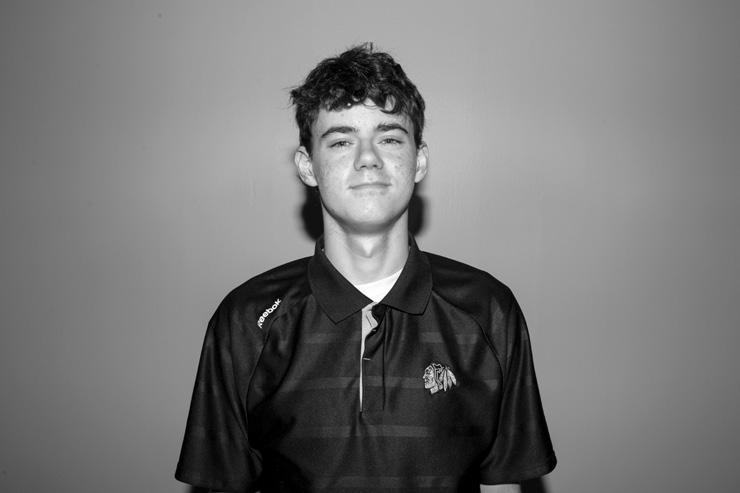
“The bottom line is, not to be callous, but if a player is really not playing, it’s not like you lose anything that way.”
Iowa football head coach Kirk Ferentz
STAT OF THE WEEK
the Iowa women’s soccer team’s rank in the latest United Soccer Coaches Poll, marking the first top-10 ranking in program history.
Jack Birmingham Sports Reporter
Two of the biggest components of the success of Iowa women’s basketball last season were head coach Lisa Bluder and superstar Caitlin Clark. But, with this dynamic duo moving on, the program will have to look deeper into its roster to continue its success.
Taylor McCabe is a rising thirdyear player on the squad, and the Nebraska native has a chance to make a big name for herself in an already blossoming program.
While significant media attention remains on third-year Hannah Stuelke and Villanova transfer Lucy Olsen, players like McCabe have to stand out to gain recognition — but McCabe has been a standout for quite some time now.
There’s a number of things that separate McCabe from the competition.
the top assistant coach in college football, in 2021. He runs a traditional 3-4 defense that is known for mixing different packages up front.
Linebacker Jordan Turner has recorded a team-high 37 tackles, while cornerback Charles Brantley has led the way with three interceptions. Turner transferred in from conference rival Wisconsin and has not only produced on the field but has also given this team a vital leader in the locker room.
Brantley battled injuries during the 2022 and 2023 seasons but has responded this season with 23 tackles to go along with his three interceptions.
Brantley’s best game of the season was MSU’s contest against Oregon on Oct. 4, earning nine tackles and one interception on the road
against the No. 6 Ducks.
Special teams
Sixth-year placekicker Jonathan Kim has done his job all season, knocking in all nine of his field goal attempts and only missing one extra point.
Second-year punter Ryan Eckley has also played well, averaging 48 yards per punt on 23 attempts.
Final analysis
Iowa has far more talent than Michigan State, but the Spartans are coming off a bye week and look to claim a signature win as they push for bowl eligibility. The Hawkeyes will be favored here, but expect Michigan State to make this a close, hard-fought game to the final buzzer.
What is your favorite Iowa City restaurant? Can I say Bread Garden? Does that count as a restaurant? Bread Garden just has everything, and you can’t go wrong.

What is the best sporting event at Iowa outside of field hockey? Women’s basketball. It is just a great atmosphere and environment, and we have some friends on the team.
What were some other colleges you were considering before coming to Iowa?
I looked at Ohio State, Boston College, and Duke. I honestly didn’t want to come out to Iowa on a visit. I’m from Pennsylvania, and it’s 13 hours away. When I got here and spent the day with the team, I told my mom in the car that I was coming to school here. She was like, ‘Oh my gosh that’s so far away, let’s talk about it.’ And I was like,
“There is nothing to talk about. I have made the
What was the main reason you came to Iowa?
The team was one of them, and the coaching staff made me feel super welcome. They wanted to win, and I wanted to win. That is one of the main things about Iowa — tradition excellence. I really enjoyed my time here when I first came out and enjoyed my time here the past five years.
What is your favorite memory here in Iowa field hockey?
When we beat Michigan, it was one versus two. We played them here on our home field. We won in shootouts, so double overtime. The wrestling team and all the other people here stormed the field, which I never thought I would see in a field hockey game.
breakout basketball player?

She was ranked the No. 88 recruit nationally in 2022 by ESPN — the only Nebraska player to receive such an honor — and fin ished a successful high school run with 2,000 career points. McCabe has handled the chal lenges and pressures of college basketball well, scoring 12 points against Big Ten opponent Rutgers as a first-year in the 2022-23 season, leading Iowa to a 111-57 victory. As a second-year, McCabe kept momentum rolling as the Hawkeyes advanced to the national championship game for the second consecutive season.
During the 2023-24 season, McCabe logged a career-high 18 points from six three-pointers against the Florida Gulf Coast Eagles. And against Minnesota on Feb. 28, McCabe shot 71.4 percent from the arc during a 108-60 win over the Golden Gophers. While players like Stuelke and Olsen have earned their fair share of attention as Clark moves on to the WNBA, the importance of the rest of the squad cannot be understated. McCabe represents the building talent that is Iowa women’s basketball.
Brock Harding
The Iowa men’s basketball team has many potential breakout candidates for this upcoming season.
The popular choice would be to choose guard Josh Dix or center Owen Freeman, starters who established themselves as rising stars in the Big Ten last season.
But of all the players on this Hawkeye roster, point guard Brock Harding will make the biggest jump from last season and break out as one of the league’s best young talents this year. Harding didn’t blow anyone away with numbers he produced as a first-year, averaging just three points per game while shooting 36 percent from the field and 37 percent from beyond the arc.
But the sophomore is expected to have a different role with
Iowa this season. Last year, Harding had to split time with upperclassmen guards Tony Perkins and Dasonte Bowen, sometimes seeing less than five minutes of game action.
Both Perkins and Bowen entered the transfer portal in the offseason, paving the way for Harding to fill the starting point guard position. Despite limited playing time, Harding showed plenty of potential, as his craftiness off the bench sparked a lot of comebacks for head coach Fran McCaffery. Harding showed just how good of a true point guard he can be, displaying his ability to drive to the paint and make a play for either himself or a teammate, something the Hawkeyes desperately need on a nightly basis.
These moments showed Iowa fans the high potential Harding has when in control of the offense. With an increased role and a year of offseason development, I think Harding can be the next great point guard under McCaffery and lead the Hawkeyes to success this season.
Sports Reporter
Isabella Tisdale | The Daily Iowan
Iowa defensive lineman Max Llewellyn and linebacker Kyler Fisher celebrate after a defensive stop during a football game between Iowa and Washington at Kinnick Stadium in Iowa City on Oct. 12. The Hawkeyes defeated the Huskies, 40-16.
I come in, and the rest of the exhibit team comes in to bring it to life.”
The exhibit features some historic moments in not just Iowa sports, but sports overall.
Many of the antique items on display were loaned from the Iowa Special Collections and Archives or the Athletics Hall of Fame. Among those items include letters written on a typewriter, black and white pictures, name tags, and historical books.
“Dr. Sterling has been researching using our archives for many years, so she kind of already had an idea of some of the things that she wanted to put into the exhibit,” Pinkham said. “This is a really great way to pull some of those things out and put them within the context of a story.”
Due to limited space, not everything Sterling came across was put on display. For example, the 1956 men’s basketball National Championship game between Iowa and San Francisco featured former NBA superstar and basketball pioneer Bill Russell, but there wasn’t enough room in the exhibit to include that information.
“Not everything can make the cut,” Sterling said. “It was really mostly little things, stories that I didn’t expand upon as much as I wanted to or could’ve ... But there’s only so much space in a physical exhibit.”
But one thing that Sterling was looking to do with this exhibit was emphasize the rich history of women’s athletics at Iowa.
“There were stories that I knew I wanted to put in,” Sterling said. “[I] had to talk about some of the lawsuits and challenges that women athletics have made, particularly here.”
In Washington, D.C., sits the Smithsonian National Museum of African American History and Culture, or NMAAHC — the world’s largest museum dedicated to African-American history and culture.
Damion Thomas, a sports curator at the NMAAHC, visited to Iowa City to hold a lecture on Oct. 8 to talk about his museum and the importance of learning about the history of sports.
“This is important because when I think about what my mission is, it is to use history to inspire, to uplift and
adversity in her first season due to an injury.
“One of the reasons she did get hurt her freshman year is because she goes so hard in every situation,” Cellucci said. “She was just busting it and ruptured her quad because she was working so hard.”
Short’s injury was an obvious setback, but the time away from the field caused her
The team dynamic, in addition to Gyamfi and returning stars Sydney Affolter and Hannah Stuelke, also includes newcomers like first-year Taylor Stremlow.
Stremlow, a four-star from Wisconsin, echoed Gyamfi’s sentiment, adding that the team remains popular despite losing Clark, who led Division I women in points per game last season.
“Obviously, what Caitlin and Coach Bluder did here was incredible and really set the stage for those of us that are new here,” Stremlow said. “I think it’s incredible to see the fans that came for Caitlin and coach have stayed for all of us. They’re just as invested and just as excited, which is pretty incredible.”
The Hawkeyes remain close-knit going into the new campaign, having sold out Carver-Hawkeye Arena for this and last season, a memory Jensen fondly recounted.
“That was a moment,” Jensen said. “A testament to all that was. Really, a testament to this fan base, of their belief in not only what was but what can be. That kind of thinking is right up my alley. For the fans to be as excited as they were a year ago about such a

encourage you,” Thomas said. “What I try to do with my history is to defend the honor, humanity, and brilliance of life. And it’s those things that really compel me to have to do this kind of thing.”
He got the chance to visit Sterling’s Iowa exhibit and said he was very impressed. He advises students to take advantage of the exhibit and learn about the school’s rich sporting history while it’s here.
Even after it’s removed, a virtual copy of the “Hawk-
to learn more about the technicalities of the sport while watching it from a different perspective.
“I really wanted to integrate myself,”
Short said. “But to be honest, it was fine. I had a great time and learned a lot from being on the sideline and watching. I experienced it all. Yes, I did miss playing, but I still learned a lot. I inserted myself into the team, too, and it worked out okay.”
The injury gave Short ample time to pre-
young and rebuilding and youthful perspective, that is just really cool.”
Gyamfi noted that the team, including the new additions, has gotten even closer over time.
“I’ve always been really close with all the girls on the team, ever since I got here my freshman year,” Gyamfi said.
“There’s a lot of newbies, so I have a different relationship with every person on the team. I think I’ve gotten closer throughout the months to all of them, so it’s been really good.”
Stremlow, who averaged 16.1 points per game as a high school junior, said the relationships are the greatest part of being at Iowa.
“I was really surprised with how quickly I connected with everybody in different ways,” Stremlow said. “I felt like I didn’t miss a beat getting to know them and getting close with them. They’ve been great.”
The new Hawkeyes will take the court at Carver-Hawkeye Arena in their first game, an exhibition against Missouri Western, on Wednesday, Oct. 30.
The first regular home game will be played against Northern Illinois on Wednesday, Nov. 6, with both games expected to receive coverage from both Big Ten Plus and the Hawkeye Radio Network.

Edited by Will Shortz No. 0911

eye Histories Sporting Stories” exhibit will be made and posted on the university website.
“I think this is really important because it’s important to share local history and local stories as well and how it is that you frame things,” Thomas said. “Change doesn’t happen because time passes. It happens because people push and bite and claw and demand to be heard. And that’s one of the great things I like about the exhibition, is that it really emphasizes some of those stories.”
pare for her sophomore campaign and to establish herself as one of the more consistent players on the Iowa defensive unit.
In her second season with the Hawkeyes, Short has logged the second most minutes on the team with 1,127, playing 60 minutes or more in 15 of the team’s 19 contests.
As the season hits its final stretch, Cellucci wants to see improvements in leadership and vocality.
“It’s not an easy thing at this age, especially young women, to hold each other accountable,” Cellucci said. “But she is one of the better ones I have seen in years.”
“Her physical fitness has really gone off the charts,” Cellucci said. “She got multiple [personal records] this August, and that has absolutely changed her game and just her position within the conference and nationally, too, being looked at as a center back that’s just really capable and able to play a high level for 60 to 70 minutes.”




Ryan Paris | The Daily Iowan
The Hawkeye Histories gallery is seen in the University of Iowa Main Library on Aug. 26. The exhibit opened Aug. 26 and will continue showing until Dec. 19.
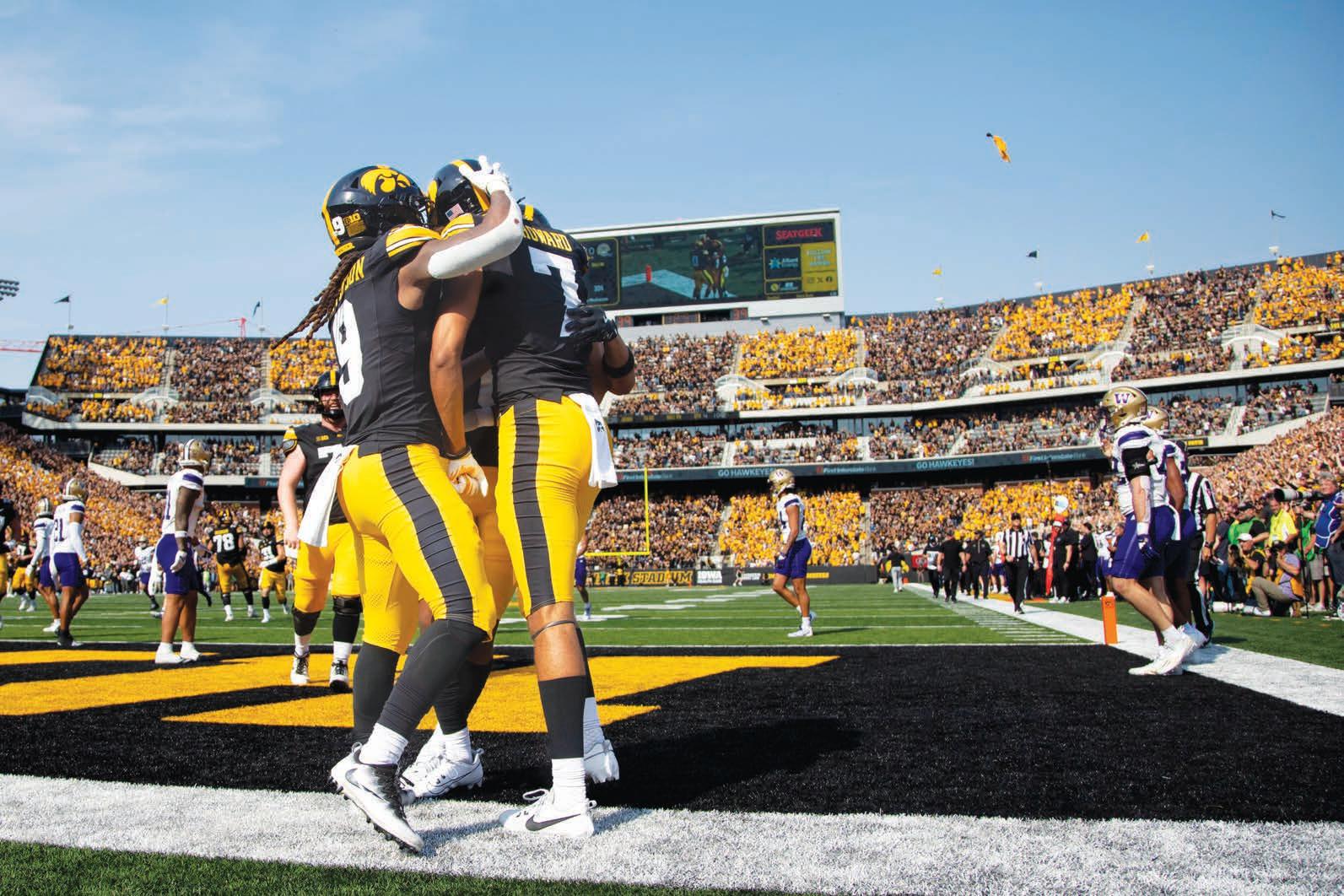
HUNTING THE HUSKIES
Iowa defeated Washington, 40-16, at Kinnick Stadium on Saturday in Iowa City. There were 69,250 people in attendance for the Black and Gold spirit game and home Big Ten opener, marking Iowa’s first game against an expanded Big Ten opponent.
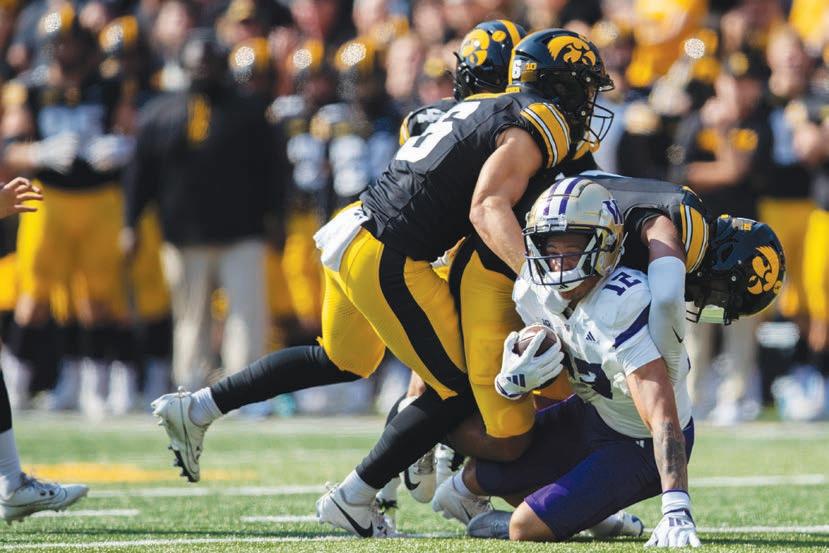
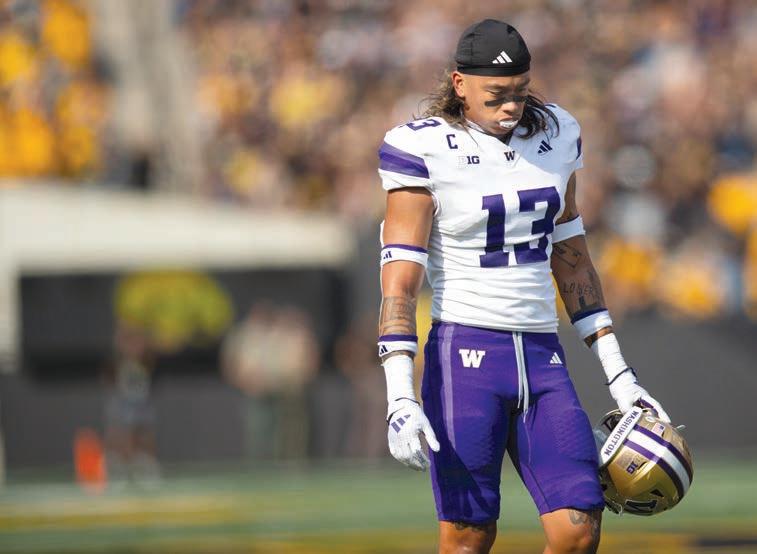

Emma Calabro and Isabella Tisdale | The Daily Iowan
(Top) Iowa running back Jaziun Patterson and wide receiver Dayton Howard celebrate a touchdown
game between Washington and Iowa at Kinnick Stadium in Iowa City on Oct. 12. The Hawkeyes defeated the Huskies, 40-16. (Left) Iowa linebacker Jay Higgins and defensive back Xavier Nwankpa tackle
running back Cameron Davis during
football game between Washington and Iowa at Kinnick Stadium in Iowa City on Oct. 12. Higgins hit double-digit tackles for the third time this season. (Right) Washington wide receiver Audric Harris stands on the sidelines during a timeout at a football game between Washington and Iowa at Kinnick Stadium in Iowa City on Oct. 12. Following the matchup, the Huskies’ record sits at 4-3 for the season and 2-2 in conference play. In their first meeting in the
wide receiver Dayton Howard scores

Reel Change
The need to understand and pREserve cinema’s history is critical.
Ilustration by Amy Scott
The Daily Iowan
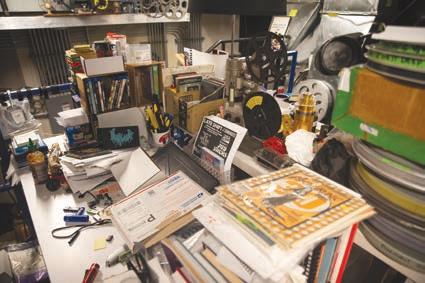
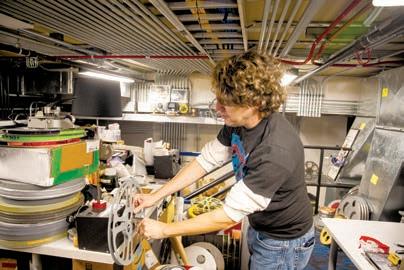

Recognizing the importance of preserving reel cinema
In an increasingly digital age, preservationists inspire hope for the lifespans of cinema’s most important films, which often falls to the wayside.
Olin Myhre Arts Reporter arts@dailyiowan.com
Charlie Hickman Arts Editor charlie.hickman@dailyiowan.com
The projector whirs as film stock unspools into chugging machinery and diligent projectionists strain to lug large metal containers across a cluttered room. This is a common scene in FilmScene’s compact projector booth, sitting right above the seats in Theater One.
Hours earlier, FilmScene staff would have met delivery drivers to haul several film canisters in preparation for a showing. Before loading the reels into the projector, the cinema operator must scan the film print and note any discrepancies between distributor and recipient.
Much like when galleries transfer paintings, the distributor lists every degradation, such as scratches, on a film print for theater employees to ensure that nothing changes during transportation. Once the inspection is complete, the print can be prepared for projection.
“Each reel would be about 20 minutes of film. So, you load up reel one here and reel two there, and then you switch back and forth every 20 minutes,” FilmScene Head Projectionist and Facilities Director Ross Meyer said. “That’s basically the way projectors were from the beginning of cinema up until the 1980s.
In the 1920s, cinema became a staple in the American pop culture lexicon. Hundreds of film prints were produced and distributed to theaters nationwide every year only to be destroyed due to short-sighted reverence.
The Film Foundation, a nonprofit founded by Martin Scorsese, has estimated that half of American films made before 1950, and 90 percent made before 1929, have been lost forever.
In the 1980s, as the medium grew and became more profit-driven, theaters became even less delicate with projected films. Once handled by unionized projectionists, the 1980s mall boom created further preservation issues.
“You didn’t have trained people there keeping an eye on things. You had a high school kid who also has to run out and sell tickets or sweep up popcorn,” Meyer explained. “Film itself was thought of as much more disposable.”
By 1999, upon the release of “Star Wars: The Phantom Menace” and the subsequent digital filmmaking revolution, 35mm film became obsolete across the U.S. Now, as digital filmmaking dominates, there are fewer and fewer dedicated projectionists.
“You didn’t have trained people there keeping an eye on things. You had a high school kid who also has to run out and sell tickets or sweep up popcorn. Film itself was thought of as much more disposable .”
Ross Meyer FilmScene head projectionist and facilities director
But Meyer and his staff still love the intricate projection process.
Digitization wasn’t all bad. According to a report written by Jason Hellerman, the Digital Age ushered forth an era of film restoration. Today’s hi-def 4K DVDs and streaming services aren’t plagued by the dust physical film stock so readily attracts.
Janus Films, a restoration and distribution company, made it their mission to digitally restore deteriorating reels. Restoring films like Charlie Chaplin’s “Gold Rush” or Akira Kurosawa’s seminal “Seven Samurai” has made classics more accessible than ever.
Not only did this democratize the medium, but it also allowed theaters to more easily present important films the way they were meant to be seen — on the big screen.
This is FilmScene’s mission. From “Predator” to “Psycho,” the theater ensures its programming balances camp and challenge.
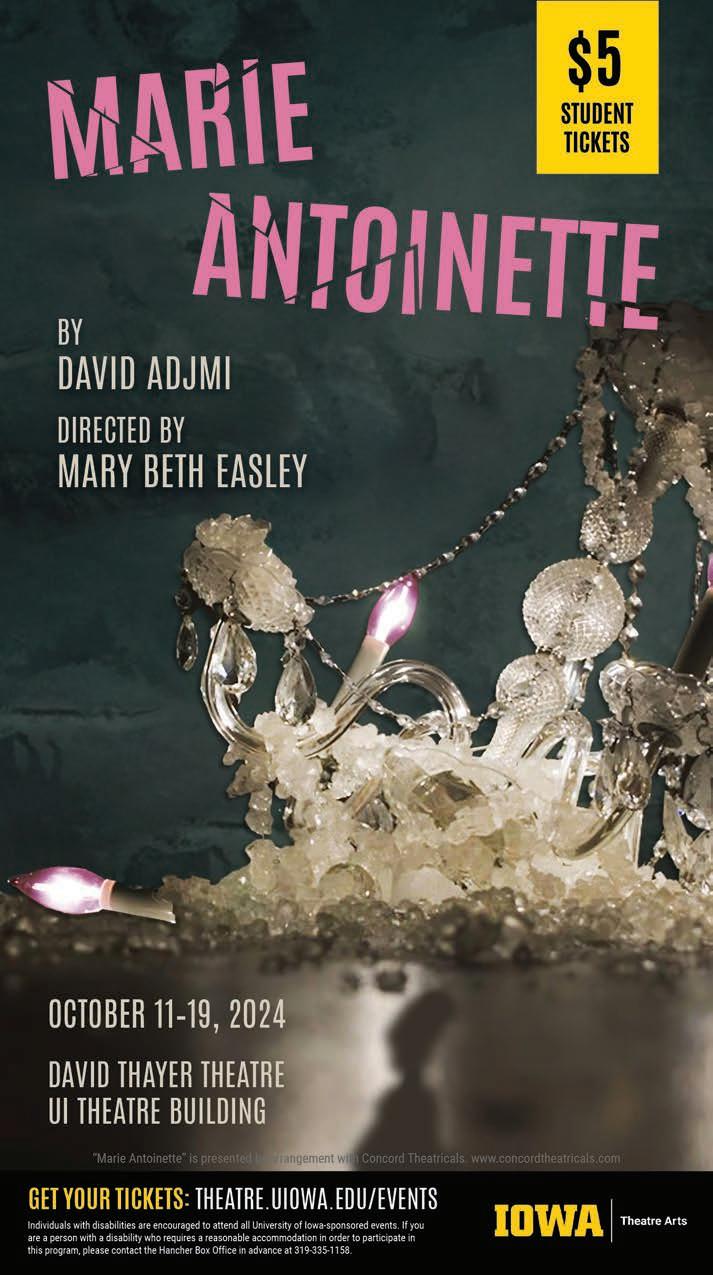
Repertory screenings, which is showing films after their initial release, have been a foundational aspect of the theater’s programming for over a decade, and the idea went mainstream during the pandemic.
“[Rep screenings] preserve art and culture, but it’s also important to share with an audience because the film is suited for that experience,” FilmScene Programming Director Ben Delgado said. “Seeing films in a theater is how creative teams want you to view those films, so preserving that legacy and sharing art with the community is important.”

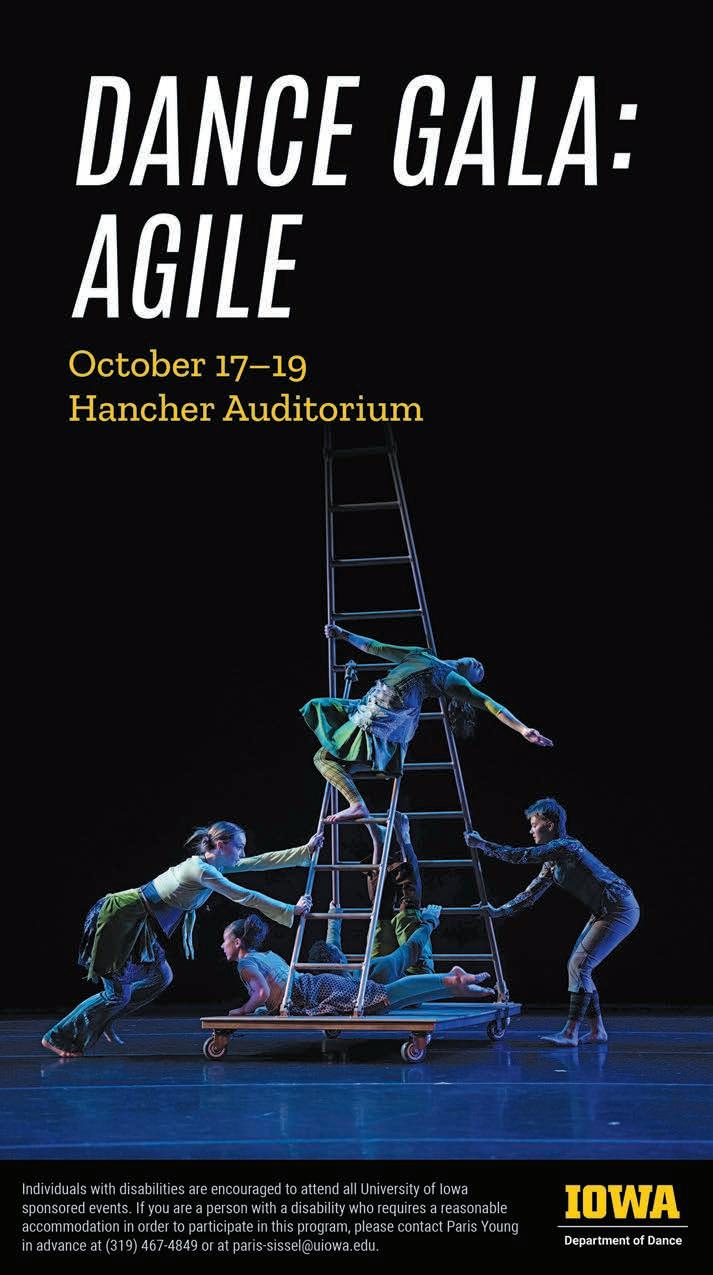
John Charlson | The Daily Iowan (Left) Assorted supplies, memorabilia, and old film reels sit on a desk inside the projection room of the FilmScene theater at The Chauncey on Oct. 9. (Middle) A 16mm film projector sits inside the projection room of the FilmScene theater at The Chauncey on Oct. 9. (Right) An 8mm film editor sits inside the projection room of the FilmScene theater at The Chauncey on Oct. 9. Graphic
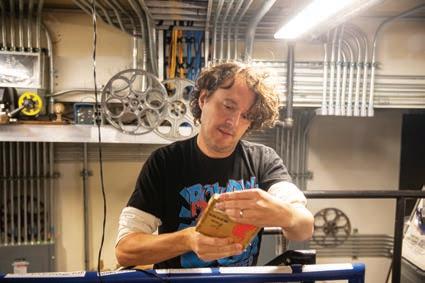
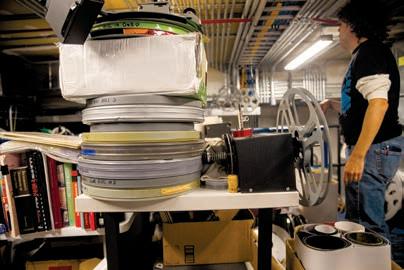
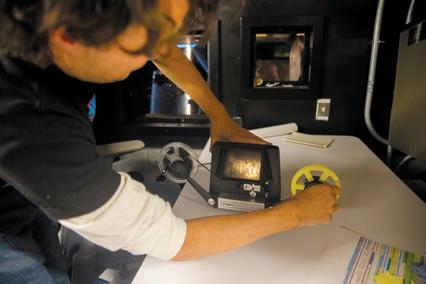
bring their reverence to institutions nationwide.
In addition to preserving the experience, rep screenings recontextualize older films for modern culture. FilmScene’s recent “Hitch Girl Summer” series promoted Alfred Hitchcock films starring women.
Hitchcock had tumultuous relationships with actors, specifically women, famously stating, “All actors should be treated like cattle.” With decades of hindsight, audiences now view his films to analyze gender roles and representation.
In 2022, FilmScene was granted the rights to show the only existing copy of “Predator” on 35mm. In collaboration with the Iowa Nonfiction Writing Program, author Ander Monson spoke about the film.
Monson is the author of “Predator: A Memoir, a Movie, an Obsession” and uses the film to examine how white, male, mainstream culture shaped an era of life.
“Predator” prompts questions and critiques on fandom, masculinity, and general relationships with acts of mass violence.
“If I get hit by a bus tomorrow, at least my film collection is here .”
“We feel it necessary to discuss the film and put it in context,” Delgado said. “It’s important for certain series we put on, especially if there is historically relevant context.”
Keeping old movies alive in the public consciousness services the films themselves and the audience. When exposed to older perspectives on storytelling, character, genre, and theme, viewers can begin to understand more about their place on the cultural timeline.
“You just kind of understand cinematic history more, and you learn how things sort of came to be,” Bijou Pro -
gramming Director Ben Romero said. “I think by getting into older film, it’s just an enlightening experience.”
Since 1972, the Bijou Film Board has focused on screening important, challenging films that are free for students.
“I want to challenge student audiences and broaden their idea of what film can be,” Romero said.
Our generation of movie-goers grew up with streaming and on-demand films.
Viewers can become overwhelmed by the unlimited options and second-guess their decisions, creating unsatisfactory viewing experiences.
By eliminating choice, the theater setting becomes an important factor in exposure.
“When you’re in the theater experiencing the film like audiences in the day [they] experienced it, you’re just more in tune with the movie,” Romero said. “There are fewer distractions, which is important for older films that move at a different pace than today’s blockbusters. Many people don’t have the attention span to sit through films like these, but the theater pushes you to participate with the whole film and not just be a passive viewer.”
Even if not every film can be projected on 35mm, the effort of screening old films digitally is still healthy for the filmgoing population.
On the occasion FilmScene does project a movie on film, though, the results are pure.
“When you watch something on film you understand the physicality of it, you can see the film grain,” Romero described. “You see the filmmaker’s intentions more clearly. It’s a different way of watching a movie than just clicking ‘play’ on a streaming service.”
Seeking out 35mm screenings is worth it not just for the historical value, but also for the aesthetic differences.
“These films were shot on 35mm and were meant to be exhibited that way,” FilmScene projectionist Harry Westergaard said. “The colors are much more crisp on film. The darks are darker than you would ever see on digital. When there is a black screen, you can still see pixels on a DVD, whereas on film it’s dark, just true black.”
Meyer’s old-school love for 35mm projection places him on the front lines of the film preservation fight. Projectionists like Westergaard are brought up under Meyer’s mentorship and eventually leave FilmScene to
“I’m always training new people, but the silver lining is that I’m sending these people with this new skill out to the world,” Meyer said. “I feel like I’ve somehow inherited this responsibility where I’ve accumulated this knowledge, and now it’s my job to pass it on to the next match.”
“When you watch something on film you understand the physicality of it, you can see the film grain. You see the filmmaker’s intentions more clearly. It’s a different way of watching a movie than just clicking ‘play’ on a streaming service .”
Ben Romero Bijou Programming Director
Responsibility is a key characteristic of the job. Film stock is delicate, and distributors don’t entrust their historic films to everyone.
“The time we played ‘Top Hat’ we used a Library of Congress print. They said nobody except for Ross could touch the print,” Westergaard recalled. “Sometimes they’re strict, [these films] were filmed on 35-millimeter and meant to be exhibited this way.”
The mission of the art house cinema is to exhibit film’s most historic offerings the way they were meant to be seen — but audiences have a mission, too.
It’s impossible to understand the present film landscape without first contextualizing where it has been. With the efforts of preservationists, film history has never been in safer hands.
“If I get hit by a bus tomorrow, at least my film collection is here,” Meyer said. “[It will be] surrounded by other movie people who presumably will know what to do with it and keep it safe and keep playing it for audiences.”
Arts editor Charlie Hickman also serves on the Bijou Film Board.

FILM from 1C
John Charlson | The Daily Iowan (Left) Head Projectionist and Facilities Director Ross Meyer shows off a film reel originally from the Cedar Rapids Public Library inside the projection room of the FilmScene theater at The Chauncey on Oct. 9. (Middle) Assorted supplies, memorabilia, and old film reels sit on a desk inside the projection room of the FilmScene theater at The Chauncey on Oct. 9. (Right)
Head Projectionist and Facilities Director Ross Meyer demonstrates how to use an 8mm film editor inside the projection room of the FilmScene theater at The Chauncey on Oct. 9.
Ross Meyer
FilmScene head projectionist and facilities director
Student author signs elusive HarperCollins deal
Esha Patel recently signed a publishing contract for her latest novel titled “Offtrack.”
Riley Dunn Digital Editor riley.dunn@dailyiowan.com
Esha Patel was sitting in the middle of a chemistry lecture at the University of Iowa two years ago, shuffling papers and getting notes in order when an email notification flashed across her computer screen. At first, she thought the message was a lie or scam.
Avon Books, an imprint of HarperCollins Publishers, had noticed her latest self-published romance novel, “Offtrack,” and wanted to publish it traditionally — with a professional editor.
This situation seemed surreal, as HarperCollins is one of the “Big 5” — the five largest and most prestigious publishing houses in the U.S.
“I got an email from Amy, my editor, and I was like oh my god, this cannot be real,” Patel said, “So, I emailed her and did a little research, but then the lecture started. I needed to get through the lecture so I could get on Google and start googling everything about this email.”
Patel soon discovered that Amy Baxter was, in fact, a real editor from Avon.
“My jaw dropped, and I called my parents. It was insane because I didn’t have an agent or anything like that,” Patel said.
To this day, Patel admits that she wasn’t sure how her book had been noticed among the thousands of other self-published novels scattered about the internet.
As it turns out, Baxter had been looking to publish a Formula One-inspired romance for a while and discovered “Offtrack” due to a friend’s recommendation.
“I thought her writing style was brilliant. She knew F1 inside out and has a great way of engaging with slow-burn romance. I knew I wanted to work with her straight away,” Baxter wrote in an email to The Daily Iowan Baxter described her job as being able to find “diamonds in the rough.” For her, there is no one-size-fits-all book formula. Instead, she simply looks for great potential.
Getting a book traditionally published was an entirely new experience for Patel. Before writing “Offtrack,” Patel had self-published four other books when the COVID-19 pandemic gave her time to reflect on the long-held hobby.
For Patel, the route of self-publishing was a good first step to take on the path

to becoming an author — and one she could pursue while stuck at home during the pandemic.
“I started writing in elementary school, maybe around fifth or sixth grade, and would make up the most random stories,” Patel said. “I was also into reading and would blow through books in a week. During the pandemic, I thought I’d publish something to share my work with my family.”
Before being picked up by HarperCollins, Patel ran a small publishing operation with her mom- her primary editor and supporter.
“My mom would read everything for clarity and ensure it all sounded good. If her attention lagged, she would let me know,” Patel said.
Avon Books acquiring the rights to “Offtrack” changed the entirety of Patel’s process, as well as the content and layout of the novel itself.
Her novel stars two Formula One drivers in an enemies-to-lovers romance that fits perfectly on the shelves with other popular books. It also, originally, had a different ending.
“I don’t think it’s uncommon to have editorial feedback like that,” published author Nina Lohman said. “I know lots of people who have gotten major requests for rewrites. Whether to take them is
something authors have to decide — do they trust the way their story is going?”
Lohman is the founder and publisher of “Brink,” an Iowa-based literary journal that champions hybrid forms of writing. Because of this experience, she understands the ins and outs of the publishing process.
The amount of rewriting an author must do depends on which press they are working with. It also depends on what each editor and publishing house looks for when they pick up a work.
For Baxter and HarperCollins, leaning into the more romance-heavy aspects of Patel’s novel was necessary.
“Editing happens all the time in publishing, it’s a lot of what makes up my job as an editor,” Baxter said. “Esha’s original book was more of a general book on F1 with romance as one of many plots, so we reworked the book to make it a romance first and foremost.”
Patel admits the editing process was difficult but rewarding. Entire chapters were deleted, and scenes were rewritten. Additionally, the original version of “Offtrack” was pulled from online shelves.
“I remember taking the original ‘Offtrack’ down. It was such an emotional moment because I remembered putting that book together,” Patel said. “And
when it returns, it will be in a different form, cover and all.”
Patel made sure she knew all the details of her Avon Books contract before signing, even sending it to her parents, a lawyer friend overseas, and various legal services before committing.
“That was probably the most overwhelming part for me, just because the contract had all this legal jargon that I never thought I’d see and suddenly it’s all right there,” Patel said. “And if I click with my little mouse and sign — I sign with an imprint for HarperCollins.”
Despite her hard work and passion for reading and writing, Patel did not come to the UI to explore the creative writing program. Instead, she is pursuing a psychology major and taking multiple STEM courses on the pre-med track.
Patel said it has been difficult for her to balance her time between being a fulltime student and a part-time author. However, she gets through by blocking out her time and treating writing like a “reward” at the end of a long day of classes.
Patel’s favorite part of writing the book was portraying a strong woman of color as a main character who was also competing in a sport traditionally catered toward men. With how much the character meant to her, she was elated by how many people picked up the book when it was released on Sept. 24.
The publishing industry can be incredibly discouraging since writers are competing against one another.
“I both submit work and publish work. I know what it’s like to have my work selected and rejected,” Lohman said. “So, keep submitting. Just keep going.”
This rings true with Patel’s journey, as she is a self-published author who is now looking toward releasing her second traditionally published novel.
“I think people get stuck in the idea that you have to have an agent and follow certain steps, or you have to self-publish,” Lohman said. “But there is more than one way of doing this right.”
Patel’s next book, “Overdrive,” will be released in the UK next month. She is excited to use the upcoming story to promote romance between people from marginalized communities and once again explore the character of a powerful woman.
“As a young person in college, it’s weird,” Patel said. “I feel like I’m living a double life and moonlighting as an author.”

Contributed by Esha Patel
